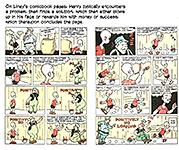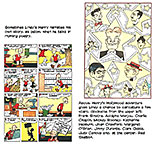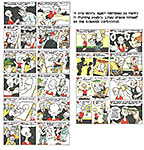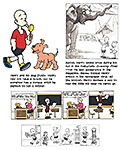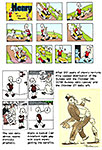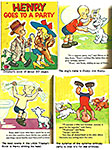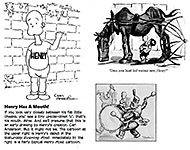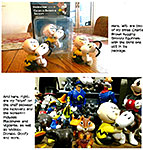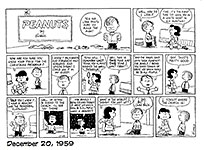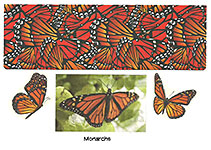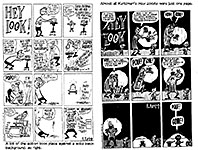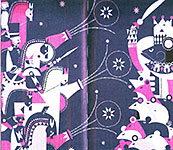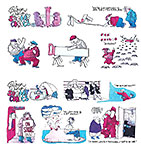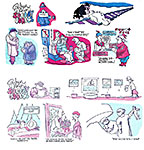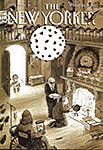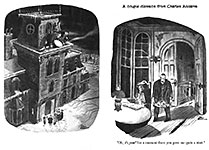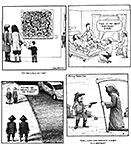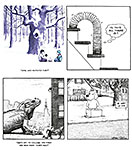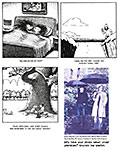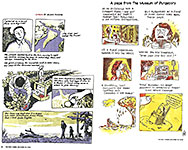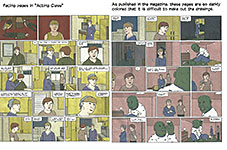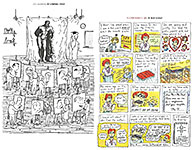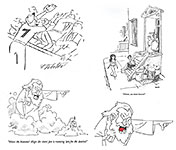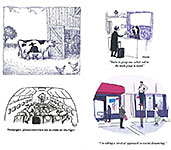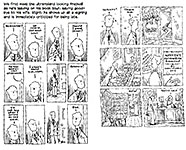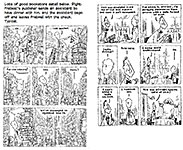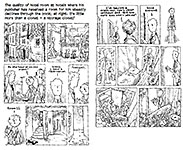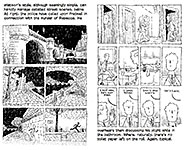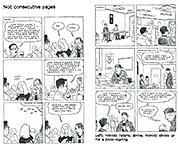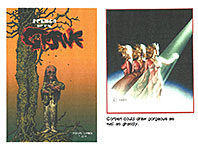 |
||||||||||||||||||||||||||||||||
Opus 412 (news thru December 28, 2020).
Here’s “part two” of our seasonal extravaganza that reviews a half-dozen
’TIS THE SEASON, KIMO SABE The Plague of the Trumpet
SULLIVANT AT LAST! Brand New Book on Legendary T.S. Sullivant
*STIR CRAZED IN PLACE Surviving the Pandemic during Lock-Down
NOUS R US *Summing Up the Comics Year by Michael Cavna 50 Years of Price Guidance *Charlie Hebdo Accomplices Found Guilty in Paris Kent State Graphic Novel Wins PW Poll Wimpy Kid Author Beats Lock-Down Cartoonist Arrested for Possessing Child Porn
ODDS & ADDENDA Cartoonist Christmas Cards at NCS Website
Further Ado Leonard Pitts, Jr. On the Christmas Spirit *CARTOONISTS IN A TRUMP-FREE WORLD Four Cartoonists and Their Views
FUNNYBOOK FAN FARE Christmas Issue of Mad Bad Mother No.4 Hellboy by Adam Hughes Miles to Go No.2 Sacred Six No.1 American Ronin No.1
TRUMPERIES The Antics and Idiocies of Our Bloviating and Delusional Buffoon in Chief
* EDITOONERY The Mock in Democracy
BIRTH OF A POLITICAL CARTOONIST Bob Englehart
The Difference between Republicons and Democrants
THE FROTH ESTATE Time’s Person of the Year
NEWSPAPER COMICS PAGE VIGIL Adults in Peanuts—A Historic Once & Other Strange and Wonderful
ACCRETION OF INTENTION DEPARTMENT Review Of—: Henry Speaks for Himself
Rancid Raves Gallery Charlie Brown Hugging Snoopy Figurine
*BEHIND THE SCENES WITH LINUS AND ST. LUKE How Charles Schulz Got His Way with “A Charlie Brown Christmas”
Civilization’s Last Outpost Trump’s Corrupt Last Days
*EXCELSIOR! A Panel of Stan Lee Fans
BOOK MARQUEE Short Reviews Of—: The Nutcracker Gahan Wilson Sunday Comics *A Wealth of Pigeons: A Cartoon Collection The New Yorker Cartoon Issue
BOTTOM LINERS Single Panel Magazine Cartooning
LONG FORM PAGINATED CARTOON STRIPS Called Graphic Novels for the Sake of Status The Book Tour *The Loneliness of the Long-Distance Cartoonist
ONWARD, THE SPREADING PUNDITRY Will Durst Needs Help
PASSIN’ THROUGH Richard Corben Ken Spears
QUOTE OF THE MONTH If Not of A Lifetime “Goddamn it, you’ve got to be kind.”—Kurt Vonnegut
Our Motto: It takes all kinds. Live and let live. Wear glasses if you need ’em.
But it’s hard to live by this axiom in the Age of Tea Baggers, so we’ve added another motto: Seven days without comics makes one weak. (You can’t have too many mottos.)
And in the same spirit, here’s—: Chatter matters, so let’s keep talking about comics. AND—
“If we can imagine a better world, then we can make a better world.”
And our customary reminder: don’t forget to activate the “Bathroom Button” by clicking on the “print friendly version” so you can print off a copy of just this installment for reading later, at your leisure while enthroned. Without further adieu, then, here we go—:
‘TIS THE SEASON, KIMO SABE Everywhere I look, pundits are complaining about 2020, what a rotten year it was, what with the pandemic and the plague (by which latter I mean Trump), the rupture of the nation’s economy, widespread unemployment and homelessness, protests for racial justice and equality in a nation laced with systemic racism, entrenched poverty, a broken criminal justice system, police violence, and Trump inaction. Herewith, more-or-less at random, are some of what’s being said (mostly about the Trumpet)—: Trump had questioned the legitimacy of elections, attacked the free press, called for the arrest of his political opponents, encouraged white supremacists, violated anti-corruption safeguards, implemented nepotism, advocated measures that limit voting, sought more control of the civil service, claimed unbridled executive power, treated the federal government (even the White House grounds) as his own private duchy, and embraced despotic leaders around the world. After the 2020 Election was called, Trump branded the results a “fraud,” insisted he had won, and asserted that victory had been stolen from him by left-wing radicals, corrupt Democrats, and the media. He signaled to his supporters that American democracy was utterly crooked—that they shouldn’t trust the results—and many leaders of the Republican Party joined in this treacherous subversion of the Election. ... But beyond his post-Election tyrannical tantrum, the most significant bad news was this: after a full term of Trump displaying disdain for democracy, immense ineptitude (including a pandemic response that led to the preventable deaths of tens of thousands), and unabashed malice (marked by racism, misogyny, crudeness, and cruelty), Trump gained support among Americans. ... Nearly half of the electorate and an entire political party accepted, if not fully applauded, his war on democratic norms. ... With millions of Americans blase about or, worse, energized by Trump’s wide-ranging assault on democratic values—as well as his attacks on reality, rationality, and science—a threat to the political core of the nation remains, even without Trump in the White House. ... The Election demonstrated that this virulent current [of authoritarian impulses] existed beyond Trump’s narcissism. And this moment raises a pressing question for the nation: can a slide toward authoritarianism be reversed? And that’s just from David Corn in Mother Jones. David Roth in The New Republic carries on in much the same spirit—: Donald Trump will leave the White House in a blaze of truthless tweets and hapless coup attempts. Did we really expect anything else? ... There was never a chance that he would respond to an electoral defeat in anything but the most egregiously undignified way. ... He would handle it poorly, and lazily. Out of spite and out of habit, he would make idle threats and lash out where and whenever it seemed safe [an important distinction: bullies always back down if met with even ordinary resistance]. ... This is Trump going out exactly as he governed—by telling someone whose name he’d soon forget to fix a problem he didn’t care enough about to understand, and then watching television to see how well he was doing. ...Trump never really knows anything about anything. As wildly irresponsible as his behavior has been since the Election, and as queasy as it is to watch him flail and fume and feint his way through what is either an exceptionally oafish attempted coup or the single most tasteless fundraising gambit in the history of American politics, the spectacle has mostly just been confounding. ... The American culture’s reflexive deference toward men born to wealth and privilege ... has not just coddled but cultivated his every poisonous whim. In that sense, his ham-handed flirtations with authoritarianism are simply the result of him being afforded one more scoop of ice cream just before bedtime. ... The unreasoning battle that Trump is fighting, down to the last moment, is the one he has been fighting all his life—not to lead or rule but to displace whatever is not him with his own sour self. He wants everything, always, if only to keep it from anyone else. At the end, as at the beginning, it is either him or us. That’s Roth. But the news media are full of phrases and fragments of criticism of the Trumpet—: Republican conservatism based upon the self-interest of the very rich. ... a deeply tribal, all-encompassing, information resistant ethnonationalism. ... a days-long torrent of falsehoods, obfuscation, evasion, misdirection and imprecision ... 25,000 false or misleading claims (twenty-five thousand) from the Trumpet ... he’ll lash out and try to create the illusion that he’s still dominant. ... the more erratic and unstable he’ll become. ... “Trump is going to go down fighting. And he’s not afraid to take all of us down with him” (Jeet Heer at The Nation). And then, there’s the Wall, symptomatic of the Trumpet himself. From The Week, December 18—: Trump inherited 654 miles of border structure along America’s 1,900-mile border with Mexico. Over 4 years, he’s constructed 415 miles, although of that total, only about 25 miles cover areas that had no previous barriers. The rest of the new construction replaced or reinforced existing structures. To accomplish what little has been accomplished, the administration has waived dozens of regulations regarding endangered species and Native American burial sites. Portions of once protected saguaro cactus forests have been cleared, and communities’ access to the Rio Grande and canals has been cut off. In Arizona’s Organ Pipe Cactus National Monument, crews were blasting in a mountainous area known as the final resting place of Apache warriors who died in battle. “The heartbreaking thing is we’re watching them detonate these areas that will never be finished,” says Laiken Jordahl of the nonprofit Center for Biological Diversity in Arizona. He calls it “a true desecration of indigenous land.” ... Trump believes that the wall he did succeed in building will stand as a monument to his presidency—a kind of anti-Statue of Liberty. ... Some of the most invasive construction now being conducted in New Mexico’s remote Guadalupe Canyon includes some of the “most endangered and critical habitats in North America. ...
The Administration has spent more than $8 billion of the $15 billion allocated so far, making the wall one of the largest infrastructure projects in American history. So far, none of the wall has been built with Mexican money. Yes, of course—that’s all true. But the year has had a huge upside, too. Sheltering in place for most of it means I have spent more time with loved ones. And any year that can arrange for that is not a bad year at all.
SULLIVANT AT LAST! My copy arrived on December 24, Christmas Eve. And it is a Christmas present the likes of which hundreds of T.S. Sullivant fans have been waiting for—for years. For decades. For as long as I’ve known and admired the comedic drawings of this cartooning genius. Entitled A Cockeyed Menagerie: The Drawings of T.S. Sullivant, it weighs in at 400 9x12-inch pages (b/w with a color section; 2021 Fantagraphics Books hardcover, $74.99). And it is everything Sullivant fans could want— a grand and glorious tome, encyclopedic in reach and scholarly in treatment. At the Fantagraphics website: “Fantagraphics is proud to present the most comprehensive collection ever published of Sullivant's delightfully off-kilter creations, which have not seen the light of day since their initial appearance in pioneering humor magazines over a century ago.” Yes, I had a role in creating this seriously humorous compilation. I collected most of the cartoons, scouring the old humor magazine Life through nearly four decades of Sullivant’s run in it, and I wrote a biographical appreciation for the Introduction. But Sullivant exceeds anything any single one of us could do: we all stand in his shadow. And now you can pre-order your copy of this landmark publication at fantagraphics.com
We’ll do a more expansive review next time.
STIR CRAZED IN PLACE During the Great Pandemic of 2020 AS I WRITE THIS, it’s been 40 weeks since my wife and I started sheltering in place. We started on a Tuesday, March 17, St. Patrick’s Day. And before this opus gets posted, at least two more weeks will have passed. And how are we faring? Candidly, pretty damn well. At our advanced ages, we never vigorously recreated outside much anyhow. I miss drives and walks in the mountains: to take them was one of the reasons we moved here thirteen years ago. But I can see the front range, bunched up at the western edge of the Great American Desert, just on the horizon. We live on the northeastern shoulder of the Denver metropolitan area in a housing development that is surrounded by open farmland. No tall buildings. Not many buildings at all except for the houses in the development. I can see a little of the front range from our front porch. And whenever we drive somewhere (to the grocery story or the liquor store—one needs sustenance at times like these), we see the mountains piled up against the sky in the west. So my privation is not complete. I’m retired from any money-making employment: the work I do is writing this online magazine for posting once a month. And Harv’s Hindsight, the history and biography department, also posted once a month. And I can do that just fine whether quarantined or not. In
fact, the lock-down hasn’t changed my daily routine much at all. I have been
living like this for almost twenty years, glued to the keyboard half-a-day at a
time. (Near here is a photo of what I see every morning when I report for
work—on the shelf just below the computer screen.) The lockdown has resulted in my writing more every month. The postings are longer. (More tedious, no doubt.) Dunno whether longer means better. That’s up to you. I’m enjoying myself. Just the same as I would if I weren’t sheltering in place, locked down and quarantined. I do a little more research these days. I write in the mornings and read in the afternoons. When tempted away from the ancestral manse in the olden pre-pandemic days, I’d waste afternoons wandering in stores, spending money excessively and not doing much research. Now that delinquency has been corrected. I go to the comicbook shop every 3-4 weeks. I miss going more often, but not because I need to buy more comics. I subscribe to a mail-order service, G-Mart: I order a month’s worth of comics from the Diamond catalog, and G-Mart delivers through the mail as the comics come in. So I get what I need, pretty much. I have relied upon the comicbook shop for DC Comics. Since DC’s withdrawn from the Diamond distribution system, the only way I know what Batman’s up to this week is by scanning the comics at the shop. And at this season of the year, I miss shopping—wandering malls and aisles amid throngs of people in a seasonal mood with Christmas carols hovering over it all. Instead, we shop remotely in the Web’s catalogs, viewing and picking and choosing online. The results come through the front door from the Postal Service. Kind of drab for a holiday. One of our amusements here is watching the neighbor’s dog. (How’s that for a comment on our pandemic times? Our entertainment consists of watching a dog.) Our kitchen window looks out over their back porch, where their dog does unusual things. It’s a Boston terrier and only six months old or thereabouts. The day after the snow fell, the neighbor kids piled up quite a lot of it to reach from their porch floor to the ground below, and they tapered it off as it descended so they have a snow slide. It’s too short to last long as entertainment for the kids, but then they got the dog involved. They brought out a plastic box lid, about two-by-three feet, and put it on the upper part of the snow slide. Then they put the dog on it and gave it a gentle shove. This make-shift snowboard went the four feet to the bottom pretty quickly. And—lo and behold—the dog liked it! Now whenever they play snowboard with the dog, when the thing reaches the bottom of the snow slide, he hops off and takes the thing in his mouth to return it to the top of the slide. Fun to watch. And so we do. Stirred but not shaken.
NOUS R US Some of All the News That Gives Us Fits
SUMMING UP THE COMICS YEAR At the Washington Post, Michael Cavna attempted to sum up the comics year, and it wasn’t all bad. True, comic shops were shuttered by the hundreds, he began. Cartoonists canceled long-planned bookstore tours, and the grand gatherings from San Diego Comic-Con on down became virtual versions of themselves. “Given such obstacles, 2020 was the year that the comics industry could have taken cover, merely trying to survive,” said Cavna. Yet graphic novelists and other comics storytellers adapted and rose to ongoing challenges. Authors hunkering down at home became Zoom ’toonists, sometimes drawing remotely for fans, sometimes reading their works to school-age audiences in quarantine. And by the fall, North American graphic novel sales were up more than 40 percent — boosted significantly by manga and the “Dog Man” publishing empire of Dav Pilkey. Cavna then goes on to briefly outline five of the main comics trends “that helped define 2020, along with the books that propelled the industry to new heights.” Herewith, Cavna—: 1. Comics representation mattered. Amid the year’s reckoning over race in America, graphic novels continued to give voice to once-underrepresented stories, and creators of color drew critical acclaim. Shortly before George Floyd’s death sparked international protests, Gene Luen Yang and artist Gurihiru released the graphic novel “Superman Smashes the Klan.” ... Other heralded culturally diverse stories included “Almost American Girl,” Robin Ha’s illustrated memoir about suddenly relocating from South Korea to Alabama as a teenager; “When Stars Are Scattered,” in which Victoria Jamieson helps tell Omar Mohamed’s true story of growing up in a Somali refugee camp; and “Long Way Down,” as Jason Reynolds’s free-verse story got a graphic-novel adaptation with artist Danica Novgorodoff. Plus, “Class Act,” Jerry Craft’s latest book about middle-school life, arrived months after his “New Kid” won the Newbery Medal. 2. Comics fed the quarantining soul. As in-person comics conventions from coast to coast toppled like dominoes, creators and fans were missing these bonding pilgrimages. And one of the best recollections of this life was Adrian Tomine’s “The Loneliness of the Long-Distance Cartoonist” — released during the summer’s virtual Comic-Con — in which the acclaimed author offers sharply felt insights into how he experiences this specific culture. [Reviewed down the scroll.] Other graphic novel types explored sports and music 3. Politics was front and center. Comics collections that lampooned President Trump were plentiful, including Garry Trudeau’s “Doonesbury” book “Lewser!,” Tom Tomorrow’s “This Modern World” release “Life in the Stupidverse” and Ruben Bolling’s “Tom the Dancing Bug” compendium “Into the Trumpverse.” Yet broader and more historical takes on politics were also abundant. The most powerful of them all was “Kent State: Four Dead in Ohio,” a deep journalistic dive into the still-resonant ’70s tragedy by Ohio native Derf Backderf (“My Friend Dahmer”). [I reviewed it in my Hare Tonic column at the Comics Journal online, tcj.com.] 4. LGBTQ representation keeps growing. Trung Le Nguyen delivered a sparkling debut with his graphic novel “The Magic Fish,” about the child of Vietnamese immigrants who teaches through fairy tales — yet wrestles with how to come out to his family. Also noteworthy were “You Brought Me the Ocean,” by Alex Sanchez and Julie Maroh, “The Times I Knew I Was Gay,” by Eleanor Crewes, Sophie Yanow’s hitchhiking-toward-discovery tale “The Contradictions,” and Noelle Stevenson’s memoir, “The Fire Never Goes Out.” 5. Youth was served. As young readers attended school from home, they could take breaks with deft new illustrated literature, much of it almost nostalgically set in schools. The year’s best YA books included Terri Libenson’s “Becoming Brianna,” Lisa Brown’s “The Phantom Twin” and Maria Scrivan’s “Nat Enough.” Then there were Pilkey (“Dog Man” and “Cat Kid” books) and Jeff Kinney (“Diary of a Wimpy Kid: The Deep End”), who helped power the kids’ market with relentlessly strong sales — a trend that shows no sign of flagging in 2021.
50 YEARS OF PRICE GUIDANCE The Overstreet Comic Book Price Guide celebrated its 50th year this year. It began in 1970, which is just about when I started buying comicbooks again after a hiatus of about 15 years when I was indulged in such “grown up” and therefore comicbook-less activities as college and the U.S. Navy. Overstreet commemorated the present occasion with a “special 50th anniversary edition” that doesn’t look much different from the non-commemorative edition. To
celebrate the occasion, I ordered the book with a cover by Todd McFarlane that
depicts Spider-Man and Spawn clinging to a lively looking gargoyle. Inside,
it’s pretty much the same as always. The Market Report runs from p.89 to p.176,
and a list of the Top 100 Golden Age titles joins front matter articles on Big
Little Books, the Pioneer Age (1500s-1828), Victorian Age (1646-1900), Platinum
Age (1883-1938) and a long piece “Batman Gothic Genesis” with an emphasis on
Gardner Fox. The alphabetical listing of comicbooks and their prices begins on p. 354 and runs to p.1,132. That’s 779 pages of prices. I bought my first Price Guide with No.4 in 1974. It has a cover by Don Newton depicting the Justice Society of America. Newton did several covers in the early years. Overstreet did the covers for the second and third editions; the cover of the first edition simply depicted comicbook publisher’s logos. Overstreet recruited Joe Kubert for No.5, who covered it with Tarzan. After that, the cover artist was usually a professional. With No.6, Will Eisner joined those ranks. And then with No.8, Bill Ward shows up, treating us all to a pulchritudenous portrait of his Torchy in one of her form-fitting, er, “gowns” to celebrate “women in comics” with sexy pictures of various superheroines in scanty attire—scarcely the sort of festivity women’s rights demand. The same kind of desecration occurs on the cover of No.44.
“All of the artists over the years have been very supportive,” Overstreet said at the 40th anniversary of the Price Guide. “Will Eisner was always there for me, and so was Carl Barks. In fact, Carl drove from California to Tennessee [where Overstreet lived] to meet me. He wanted to see the ‘factory’ where the Guide was created. He was shocked to see that the production of the book, from beginning to end, was a one-man operation. I was working full-time for a paper company as their statistician and drawing maps of their operations. I did the Guide in my spare time.” Compared to the current edition’s 300-plus pages of advertising and essays, the 1974 edition, which starts the alpha listing on p.38, has ads and articles that are virtually non-existent. The alpha listing ends on p.452, after 414 pages; this year’s alpha listing, remember, is 779 pages long. That’s a measure of how the comicbook market has grown in 50 years. It’s almost doubled. And the number of advisors (comicbook shop owners and collectors) has grown, too. For several years (maybe still; I dunno), Overstreet convened an annual meeting in the Smoky Mountains of Tennessee to discuss markets and prices. “After that meeting,” Overstreet said, “I would have a good feel for the market and how many titles were coming in, and who was buying what. The most important factors were how many books existed, the supply in certain geographic areas, and what the prices where.” This year’s anniversary special edition costs $29.95; the first Price Guide in 1970 cost $5. That was a pretty steep price for a 6x9-inch pamphlet of 32 pages. A Special Collector’s Reproduction of the first Guide was published in 1993; we’ve paired it with the 50th edition in our first illustration, above. A mint edition of Action Comics No.1 (Superman’s debut) was priced at $300 in the first Guide; this year, that comicbook in mint condition sold for $4,600,000. Mint prices for Military Comics, $70 and $8,800; Fantastic Four, $30 and $190,000; Gleason’s Daredevil, $100 and $24,500; Captain America, $150 and $550,000. Captain Marvel and other Fawcett titles weren’t even listed in 1970. One thing that hasn’t changed much: the black-and-white photos of comicbook covers are still too small to read—just as they were in No.1. But then, we don’t need to “read” the pictures, do we? We’re interested in the prices not the pictures.
CHARLIE HEBDO ACCOMPLICES FOUND GUILTY Fourteen people associated with the 2015 attacks on the satirical newspaper Charlie Hebdo and a kosher supermarket on the outskirts of Paris were arrested, tried for three months in Paris, and found guilty of involvement by a panel of French judges on Wednesday, December 16, reports James McAuley at washingtonpost.com France, far more than any other Western nation, has been a constant target of Islamist terrorists in recent years. More than 260 people have been killed here in attacks since 2012. But given the particular emotional significance of the Charlie Hebdo shooting, the verdict in this case “represented a national catharsis.” Of the 14 defendants, three were tried in absentia and five were spared the charge of terrorist complicity, sentenced only to involvement in a criminal conspiracy. The trial was hugely symbolic for France. The actual killers are all dead. The brothers who killed 12 people at the Charlie Hebdo office in Paris on January 7, 2015, were killed by police after a two-day manhunt. An accomplice, who was responsible for a related attack at the Hyper Cacher kosher supermarket on Jan. 9, 2015, that left four people dead, was killed at the scene by police. The defendants in the resulting trial were accused of either criminal conspiracy or terrorist complicity in the attacks. Ali Riza Polat, 35, was accused of having provided weapons to all three killers, charges he denied. The judges handed him the heaviest sentence of the 11 defendants present for the trial — 30 years in prison, 20 without parole. Charlie Hebdo marked the start of the trial in early September by republishing the caricatures of the prophet Muhammad, ignoring a strict prohibition in the Muslim faith on any image of the Prophet. France has suffered three terrorist attacks since then, including the gruesome beheading of Samuel Paty, a public school teacher in the Paris suburbs who had shown his students those caricatures. France’s President Emmanuel Macron’s emphatic defense of the right to publish the pictures drew ire and inspired protests across the Muslim world, and a security guard was stabbed outside the French Consulate in Jiddah, Saudi Arabia. In an interview with Al Jazeera in late October, Macron said the caricatures should not be seen as symbols of the French republic, although he added that he would not compromise on the right to publish them. The cartoons have continued to haunt France. The first of the recent attacks came in late September, when two French journalists unrelated to Charlie Hebdo were stabbed outside the newspaper’s former Paris office by a 25-year-old Pakistani man who appeared not to have realized that his target had changed location. The second was the mid-October beheading of Paty in broad daylight by a Chechen asylum seeker. That attack followed a social media campaign by a Muslim parent angered that Paty had shown the caricatures to students, although the man’s own daughter had not been present in Paty’s class on the day in question. In the third attack, in late October, three people were fatally stabbed in a basilica in Nice by a suspected Tunisian migrant who had arrived in Europe shortly before. Richard Malka, the attorney for Charlie Hebdo, spoke with emotion after the ruling. “It’s the end of something today, but I hope as well that it’s the beginning of something else: I felt, I believe — at least I hope — an awareness, an awakening, a desire to act, among citizens against a danger that kills, that wants to impose fear and terror,” he said. “This danger is not Islam — that has to be said clearly. This danger is Islamism — that is to say, a fascism — and we cannot find excuses for it.”
KENT STATE GRAPHIC NOVEL WINS PW POLL Released in September during the 50th anniversary year of the 1970 tragedy, Kent State: Four Dead in Ohio (Abrams ComicArts) by veteran comics journalist Derf Backderf garnered the majority of votes in PW’s annual Graphic Novel Critic’s Poll, receiving eight votes from a panel of 14 comics critics. In this deeply researched work, PW Staff reports, Backderf, best known for his Eisner-nominated 2012 graphic nonfiction work My Friend Dahmer, reconstructs the lives and last days of the student activists and bystanders killed when the National Guard fired on unarmed antiwar protesters on the campus of Kent State University. “The book presents a nuanced portrait of the equally young National Guardsmen, who were under extreme pressure and suffered from a severe lack of training, while deftly examining the polarized political context, anti-communist paranoia, and rampant government surveillance surrounding the anti-war movement during the Nixon administration.” The title was also chosen as a 2020 PW Best Book of the Year. Calling the title “one of the year's most tragic and insightful books of any genre,” PW comics critic Chris Barsanti praised the “weave of research and personal drama” in a methodical account of the watershed event that critic Rob Clough described as “even-handed but unrelenting.” PW critic Sarah Mirk said the book represents a timely effort to reexamine the events at Kent State during a period in American culture fraught with similar political polarization. Backderf, she said, “illuminates societal dynamics that feel eerily parallel.” My review is running in my column Hare Tonic at the online Comics Journal, tcj.com And we’ll have it here, too, in a couple of weeks.
WIMPY KID AUTHOR BEATS LOCK-DOWN Over the summer, Jeff Kinney and his publishing team were trying to figure out how to safely promote the second Rowley Jefferson book, which had already been pushed from April to August due to Covid-19. Livestream events seemed like a no-go, reports Hannah Yasharoff at USA Today— his core audience of kids roughly 8 to 12 years old was already getting an overload of Zoom time through school. The solution, Yasharoff reveals: Kinney would travel around in a van and dole out books to kids via a 7-foot golden trident that young readers could connect to the new book’s storyline and associate with the cover’s bright orange and yellow color scheme. It was a socially distant way to still let kids meet the man who created their favorite characters during a time that doesn’t allow for much in-person interaction. “I wanted to do something physical,” Kinney said. “I was really surprised by how well-received it was, even though it was literally me just handing kids a book with the trident, and I was really surprised by how grateful parents were and how happy kids were to have something to do that wasn't canceled.”
CARTOONIST ARRESTED A cartoonist famous for his work in The New Yorker has been arrested in the Hudson Valley, New York, for alleged possession of a sexual performance by a child, reports D.D. Degg at dailycartoonist.com Why do journalists do that? Why do they include the name of a famous magazine in a report about child porn? Probably because there would be no story without The New Yorker reference. I’m going to report this story without The New Yorker to see how news-worthy it is then; to wit—: A cartoonist, Dutchess County resident Daniel “Danny” P. Shanahan, 64, of Rhinebeck, was arrested by New York State Police on Wednesday, December 9, and charged with possession of a sexual performance by a child, said Trooper AJ Hicks. According to Hicks, the materials were found on his computer after a warrant was obtained by the Village of Rhinebeck Police. Danny Shanahan could face up to four years in prison, followed by 10 years of probation, if convicted as charged. Over the course of his career as a professional cartoonist, Shanahan has contributed cartoons to Time, Newsweek, New York, The New Yorker, Fortune, Playboy, Esquire, The New York Times, The Wall Street Journal and the Chicago Tribune.
ALL ACCURATE, FACTUAL REPORTAGE. But most reports also include something like this (in italics): Shanahan is a longtime New Yorker cartoonist whose work last appeared in the magazine’s February 20 issue last winter. Such a reference is unfair to both Shanahan and The New Yorker. Unfair to the cartoonist because his career is more broadly based than his association with that magazine. Unfair to The New Yorker because it connects the magazine to a charge about child pornography—as if, somehow, The New Yorker approved of child porn (maybe, even, fostered it). So why do it? Because, as I said, without The New Yorker, there is no story worth publishing. But the sensationalizing in this case didn’t end with The New Yorker. Kathy Reakes at dailyvoice.com continues by extending the sins being reported: Earlier this year, Shanahan's son, Render Stetson-Shanahan, faced murder charges in the brutal stabbing death of his college roommate Carolyn Bush, a fellow Bard graduate. The story made national headlines in 2017 because the Rhinebeck High School graduate and longtime Samuel’s Sweet Shop employee was the son of the famous cartoonist, Danny Shanahan. Render Stetson-Shanahan, was found guilty of manslaughter following a jury trial. A sampling of Danny Shanahan's cartoons may be found here. Me, again. See? They don’t let up. And I’m guilty sometimes, too; after all, I’m a journalist. Not only does The New Yorker promote child porn, they sponsor murder. Geez.
ODDS & ADDENDA At the National Cartoonists Society website, they’re wishing us a better new year that they hope will be enhanced by viewing a cornucopia of cartoonists' Christmas cards, which you can see here —:
https://www. hoganmag.com/ blog/7065
Fascinating Footnit. Much of the news retailed in the foregoing segment is culled from articles indexed at https://www.facebook.com/comicsresearchbibliography/, and eventually compiled into the Comics Research Bibliography, by Michael Rhode, who covers comic books, comic strips, animation, caricature, cartoons, bandes dessinees and related topics. It also provides links to numerous other sites that delve deeply into cartooning topics. For even more comics news, consult these three other sites: Mark Evanier’s povonline.com, Alan Gardner’s DailyCartoonist.com (now operated without Gardner by AndrewsMcMeel, D.D. Degg, editor); and Michael Cavna at voices.washingtonpost.com./comic-riffs . For delving into the history of our beloved medium, you can’t go wrong by visiting Allan Holtz’s strippersguide.blogspot.com, where Allan regularly posts rare findings from his forays into the vast reaches of newspaper microfilm files hither and yon.
FURTHER ADO Here’s what Leonard Pitts, Jr. wrote at the Miami Herald. And since he’s the greatest syndicated columnist of our age, I’d like you to have the privilege of reading it; so here it is—:
And so this is Christmas. So sang John Lennon in 1971. The Vietnam War took 2,414 American lives that year, so the song was a prayer of harmony and peace with a scrim of irony. Nor did the irony end there. Lennon was shot to death nine years later, 40 years ago Tuesday. And if the events of 1971 seemed sharply at odds with the hope of the holiday, the same can surely be said of 2020. On the surface, things seem much the same as they ever were, the same crush of manufactured joy and consumer avarice Charlie Brown’s been complaining about for 55 years. On TV, the same photogenic families stand in the driveways of the same upscale homes, beckoning you to buy a luxury car to celebrate the night when, Christians believe, heaven touched Earth. But this Christmas is not the same. It is a pandemic Christmas where death is already setting new records. Nearly 2,900 lives were lost in a single day last week, roughly equivalent to a 9/11 every 24 hours. The CDC says COVID-19 may have claimed nearly 330,000 of us by Dec. 26. Healthcare workers are physically and emotionally spent; the system is cracking under the strain. And so this is Christmas. But what is Christmas when you can’t — or at least, shouldn’t — travel? To go over the river and through the woods to grandma’s house this year is to risk exposing her to a deadly virus. Yet any year that denies you the ability to go home, to gather in a place of memory with those you love, is a year that steals something irreplaceable. That’s why carols written during World War II brim with such palpable yearning.
“I’ll be home for Christmas, if only in my dreams . . .”
“From now on, all our troubles will be out of sight . . .”
“I’m dreaming of a white Christmas, just like the ones I used to know . . .” How those words must have felt to some man sweltering in the jungles of Guadalcanal. Small wonder the Christmas that came at war’s end — 75 years ago — was “the greatest celebration in American history” in the words of Matthew Litt, author of “Christmas 1945.” It’s a book one is hard-pressed to read without smiling, tales of soldiers, sailors and Marines rushing on crowded roads and rails to get home for Christmas and people doing for one another with cheerful, thankful hearts. Americans seemed moved by something deeper than manufactured joy and consumer avarice that year. When sailors stepped off their train for a Christmas Day layover in Glenwood Springs, Colorado, the 1,200 residents met them with turkey dinners and gift-wrapped presents from beneath their own trees. A British mother wrote the only American whose name and address she knew — New York Mayor Fiorello LaGuardia — pleading for something impossible to find in war-ravaged Europe: a doll for her daughter. It was booked on a Pan Am flight and reached London on Dec. 23. This year there is, again, a need for something deeper. Something like they found in North Little Rock, Arkansas, last month after a black family erected a Black Santa Claus in their yard only to receive an anonymous note demanding removal of the “negro” elf. Iddy Kennedy said it made her wonder “if this was the right environment to raise our daughter.” Then her neighbors learned of the harassment. There are now black Santas up and down the street. People also sent money, over $1,000, which the family has redirected to the Arkansas branch of Ronald McDonald House Charities. Speaking to the Washington Post, Executive Director Janell Mason called it “humanity doing good things.” And so it is. And so, this is Christmas.
CARTOONISTS IN A TRUMP-FREE WORLD How Will They Fare? Steven Heller, writing his Daily Heller at printmag.com, looked ahead to January 20, 2021, wondered how editoonists will fare once the Trumpet has left the White House. “He will take with him the flawed persona that was a perfect foil for cartoonists, caricaturists, illustrators and acerbic artists in all media. “Like Nixon,” Heller continued, “Trump's egotistic and autocratic tendencies have fueled critical graphic commentary for four challenging years. So, from the comedic point of view, his absence may be met with both relief and remorse.” Hoping to find out how editoonists are thinking, he assembled four of “the most prolific contemporary visual satirists, visible on covers of national and international magazines—Edel Rodriguez, Barry Blitt, Steve Brodner and Ross Macdonald—to comment (and lament) on what Trump's forthcoming White House vacancy means to them now and for the future.” And here’s what they are thinking—: Said Ross Macdonald: “For four years, the president and his toadies have provided such a target-rich environment for satire that it’s hard to know what the future looks like, and how quickly Trump will fade. The general feeling I’ve heard expressed is that everyone is looking forward to having the news cycle slow down and be boring, and not having to hear about the latest Trump outrages 10 times a day. “But
somehow,” Macdonald continued, “I wonder if he’ll grant us any ease. He’s
developed an appetite for dominating the world news cycle, so he’ll probably
keep trying with hourly tweet-storms, pushing ever wilder conspiracy theories,
slagging Biden with every breath, throwing himself in front of the cameras
every chance he gets. And the media will report on him because—love him or hate
him—he’s a reliable eyeball-getter. In his own words, he’s the Golden Goose. “I hate to admit he’s right about anything, but he was right about that. So, I suspect he’ll be providing subject matter for satire for a few months at least, maybe longer. By then there’ll probably be plenty of Republican lawmakers trying to grab the spotlight with foul Trumpian antics, since they’ve seen how outrage worked for him. And maybe we’ll still have Mitch McConnell supplying material. He’s fun to draw too.” Once aroused, Macdonald kept on: “Other illustrators have said that they look forward to never having to draw him again. I look forward to him being out of the White House, and I won’t miss hearing about him from sunup to sack time every day of the week. But I won’t stop drawing him; it’s too much fun! I will miss having such a big, easy target. He could be relied on to provide a barrage of material. The dogged ignorance, obvious lies, inept buffoonery and vile corruption just kept coming in wave after wave. “Combine that with his Trump-ness,” Macdonald finished, “— the big suit that never changed, the red tie, the imagineered hairdo, the bad orange self-tanner, the lummox-like walk and tilted posture, the little eyes, delicate flitting hands, and that mouth. And he felt like the gift that kept on giving, for satirists, anyway. His wretched terribleness was not funny, but at least he looked funny doing it.” Edel
Rodriguez, who produced some spectacular Time covers, said he won’t
miss Trump at all. “I was thrilled to watch him lose the election and glad to
see Biden be elected as the new American president. I definitely feel that my
mission was accomplished. My only goal was to see Trump impeached or voted out
of office. I think he has been one of the most dangerous people this country,
and the world, has ever had to deal with. I don’t think it’s completely over,
as he has stirred something in a certain segment of Americans, but his hold on
power is sure to diminish and disappear.” Barry
Blitt, who’s made a career out of doing covers for The New Yorker, doesn’t
think Trump will go away. “He’s the Babe Ruth of negative American stereotypes.
He's brought a face to a lot of unsavory attitudes; I expect he'll be lurking
around the corner in a whole lot of cartoonist's work, mine included.” “I can’t think that any serious literate American, artist or no, will miss him,” Steve Brodner said. “But the media will very much, I fear. He was made by a mainstream press that couldn’t believe the great free show they got every day. ... CBS’s Les Moonves admitted it in the beginning: ‘It may not be good for America, but it's damn good for CBS.’” Brodner challenged the people working in media: “Can we all now understand what we created? We cannot put the sludge back in the pipeline. The pollution is widespread. Trump leaves as a cultural icon. This has been compared to a Gnostic cult, where Trump is the god figure; information of any kind is twisted to fit into a network of absurdist paranoid conspiracies. “Millions
who didn’t ever think about politics before are now cultists, resistant to
news, science, Calling Trump “the first American dictator,” Brodner went on: “Luckily he was too stupid and lazy to achieve it. We are so fucking lucky! We bought a little time to ring democracy with steel. I have already decided to draw Trump very little from now on. It is our chance to make him irrelevant. So, let’s do that. No more oxygen from anyone. He only has nonsense to dispense. Let’s give ourselves the luxury of starving Trump for a while. As John Lennon might say: Trump is over. If you want it.”
QUOTES & MOTS During an interview, John Lithgow answered a question about why we are delighted by poetry—by rhymes—saying: “It’s because they go off like little firecrackers. You know a rhyme is coming any time you get to the end of a stanza, but you hope the best rhyme of all comes at the end of a poem. And it’s just a surprise. ‘Omigod, yes, of course!’ It captivates you and holds your attention in a remarkable way.”
READ & RELISH The amount of sleep required by the average person is five minutes more.—Playwright Wilson Mizner The saddest aspect of life right now is that science gathers knowledge faster than society gathers wisdom.—Isaac Asimov Education costs money, but then so does ignorance.—Statistician Claus Moser
FUNNYBOOK FAN FARE Four-color Frolics An admirable first issue must, above all else, contain such matter as will compel a reader to buy the second issue. At the same time, while provoking curiosity through mysteriousness, a good first issue must avoid being so mysterious as to be cryptic or incomprehensible. And, thirdly, it should introduce the title’s principals, preferably in a way that makes us care about them. Fourth, a first issue should include a complete “episode”—that is, something should happen, a crisis of some kind, which is resolved by the end of the issue, without, at the same time, detracting from the cliffhanger aspect of the effort that will compel us to buy the next issue. A completed episode displays decisive action or attitude, telling us that the book’s creators can manage their medium.
HAPPY HOLIDAYS!
The Christmas issue of Mad is out, decorating the magazine shelves of
supermarkets everywhere with a jolly picture of Alfred E. Neuman wearing a
Santa beard. And the all-reprint strategy that governs this publication
nowadays has emerged into full light. A 96-page re-issue of a “special
edition,” the magazine offers 37 separate articles, each of which is dated
(with issue number) in the table of contents: it’s clear that the 60-plus-year
history of the magazine published enough Christmas articles through the years
that a “stocking stuffer” can be assembled from the past holiday issues. The
reprint scheme makes me wonder, though, whether the artists and writers get
residuals. The same sort of culling and mustering of pieces on single topics prevails at other recent (or current) issues: No.15, out just last month, is the “superspoofheroes issue”; and No.16 is the “horror” issue. The only bad thing about the StockingStuffer is that in giving it a square-back binding, the gutter inside overlaps itself, covering up portions of the artwork on facing pages. The Usual Gang of Idiots are present in these issues— Tom Richmond on tv and movie spoofs, Paul Coker (doing “the 25 worst things about Christmas”), Dave Berg (who is actually no longer with us: he died May 17, 2002), Al Jaffee on Fold-ins (although No.15 has a new guy on the feature, Johnny Sampson), Angelo Torres, and so on. New-ish among them is Emily Flake, a refugee from The New Yorker. Sergio
Aragones occupies 17 of the StockingStuffer’s 96 pages with visits to
“after Christmas,” “Winter,” “Santa,” “New Year’s Eve” etc. Plus his tiny
microscopic marginals throughout. The most spectacular of Sergio’s offerings is
a 2-page spread showing a few thousand people at a shopping mall, all
misbehaving in the usual manner of human beings everywhere. We could study this
landscape for weeks. Features in the superhero spoof include “Ecch Men,” “Superheroes Based On Real People,” “Nitwit Teenage Turtles,” and “Bat Boy and Rubin,” a comicbook reprint from Mad Comics No.8, December 1953. Tiny type on the first page of each article identifies its initial appearance. I suspect, though, that Sergio’s “Mad Look at Quarantine” might be freshly concocted: seems entirely too pertinent to be a reprint. Ditto the 2-page commemorative spread on Mort Drucker, who died just last spring, April 9. Tom Richmond, another superb caricaturist, drew the pictures and wrote the tribute to his legendary predecessor who, Richmond avers, did 300 parodies for Mad.
I AM ASTONISHED as I encounter yet again another brilliantly competent artist on the latest comicbook title I pick up. Where do all these superb artists come from? They can’t all be graduates of the Joe Kubert school. Can they? And they are all, without exception, beautifully competent storytellers. Here’s
No.4 of the 5-issue run of Bad Mother, for instance. In this issue, the
woman who has kidnaped the Bad Mother’s daughter sends a couple of assassins to
kill BM (aka April). The spread at hand begins a 6-page fight, all conducted
without speech balloons or captions. No words. Just pictures. In the spread at hand, April is in front of a mirror as the killer comes up behind her. She sees him in the mirror, and we see him, too—in the mirror. Apart from his threatening image, we also see the barrette she has in her hair, an elaborate metal design that says “#1 Mom.” The progression of images on this page keeps #1 Mom in front of us even as we see the killer advance. Then on the next page, when April throws her head back into the killer’s face, we realize as he exclaims “Fuck” that the prickly #1 Mom barrette has jabbed him in the face, causing him to drop the cord he was strangling BM with. All nicely done. I dunno why Mike Deodato Jr. breaks the page into 16 “panels,” some with no picture in them, when the story is told, in effect, in four panels. Why provide 16 focal points, which is what the division does. I understand that the last three panels on the second page—showing her terror-stricken face and her hands reaching out, grasping—focus on visual elements that express her terror. But what about the sixth panel? The one with a star-spot of light on the killer’s face but otherwise just a black blob? What’s that all about? After winning the fight and killing the killer, April goes to the murderer’s car parked outside and captures the killer’s sidekick, who happens to be the kidnapper’s son. Then once he’s tied up and gagged, she phones the kidnapper, lets her hear her son say “Mom?” and invites her to dinner. Go back and look at April’s face as the killer wraps a strangling cord around her neck. Every picture is like that: flawlessly rendered.
AND HERE’S a
page from a Hellboy and the BPRD one-shot, “The Seven Wives Club” drawn
by Adam Hughes, who, it seems to me, draws covers more than stories. But
this story is masterfully drawn. The staging is deft even if much of most
pictures is heavily cloaked in solid black shadow. Hughes knows just how much
of the picture to illuminate for storytelling purposes. And he also shows us
regularly the beautiful face of the heroine of this piece; no one is better at
beautiful female faces. Then Stephen Molnar in Miles to Go No.2 produces this page, starting
with a wonderfully atmospheric street scene then going inside a bar and then
flashing back to the old man and the young woman in the car and finishing with
a glimpse of a young woman reading a book, which leads into the next page where
the young woman has a larger role. The drawing itself is terrific—flecks of
shadow in an almost Caniffian manner. Next
to that page, we have a page from No.1 of Sacred Six by Gabriel
Ibarra, drawn, wherever perceived through deep shadow, with a wispy penline
feathering, completely different from, say, the multi-panel pages, each panel
an extreme close-up of some pictorial fragment of the story, by artist Aco in American Ronin No.1. The focus is microscopic: you wouldn’t think a
visual narrative could be conveyed in such tiny fragments. But Aco’s artwork,
while not at all photographic, is detailed and precise. Where, I ask, do all these surpassingly competent artists come from? Why haven’t we seen any evidence of the brilliance of their work before now? Or have we, and I’m just forgetting. Whatever the case, it’s clear that American comicbook illustration has passed well beyond the Jack Kirby - Wayne Boring vastnesses, which were competent enough themselves, to these isles and inlets of exquisite rendering. And it’s drawing by itself which is so impressive—lines on paper, no high-tech massaging. Different styles but the same level of superior drawing ability. And here, all this time, I thought we’d somehow left the Age of Illustration behind us. Nope: it’s invaded the four-color fold, where it amazes as it amuses. Wonderful.
TICS & TROPES “So, the toddler president is finally taking baby steps to begin the transition to the incoming Biden administration. ...” —Editoonist Nick Anderson But the cowardly Republicon Congress has yet to do anything to defray its emerging reputation as a conglomeration of idiots and fraidy cats. Let’s take names of those who have maintained a stoic silence. And then let’s vote them out of office first chance we get. No country can be governed by fools and cowards.
TRUMPERIES The Antics and Idiocies of Our Bloviating and Delusional Buffoon in Chief TRUMP WAS NOT VISIBLE for at least nine days in December, the 14th through the 22nd, a period that history will denominate “The Big Quiet.” Unheard of. We’ve not used to this. We’re accustomed to the cacophony of his constant tweeting and to the imagery of his posturing in front of whatever camera is in sight, making a thumbs-up sign. He’s obviously sick: his ego has been struck a blow that it cannot quite withstand. Under
the heading of Trumperies, we screen editoons that have the Trumpet as their
sole subject—Trump as he often sees himself and Trump as others not in his cult
see him. Handily in the former category is Dave Granlund’s portrait at
the upper left of our first visual aid. The strutting self-importance embodied
in this image is perfect for the Trumpet. Next around the clock is Patrick Chappatte, who builds an entire cartoon on Trump’s long red tie. The image, invoking that of a statue in a town square, shows Trump tripping on his tie, a convenient representation of Trump tripping himself up with successive contradictory statements. Across the bottom of this display are two This Modern World comic strips by Tom Tomorrow (aka Dan Perkins). Perkins does not deploy imagery to make his point: instead, he piles up sarcasm until it is nearly overwhelming. Sarcasm as a needle poking fun at something is tricky: it’s easy for a reader to misinterpret sarcasm, taking it to mean what it says instead of meaning the opposite. In the first panel of the strip at the lower right, for example, the actual Trump is precisely not doing “everything possible to facilitate a peaceful transition of power.” Again in the fourth panel, the speakers describe exactly what Trump cultists are doing. In this strip and the next, Perkins hones the sarcasm, concluding, finally, with a panel in which a penguin named Sparky and a Boston terrier named Blinky comment on the preceding action; they are recurring characters, and their speeches are the only ones in This Modern World that are not sarcastic. Another
of Perkins’ strips shows up in the next array, but we pause first at Pat
Bagley’s cartoon that offers an image of the Grandstanding Obstructionist
Pachyderm getting its tongue frozen to the flagpole, which will happen on days
of lower temperatures if you persist in kissing the Trumpet’s flagpole. Once
stuck, you can’t escape. You become, instead, a toothy grinning model of
cheerful servility—like the image Nick Anderson provides in the next
editoon. Below that, John Cole offers a visual metaphor of Trump as the three monkeys of lore and legend, who hear no evil, see no evil, and speak no evil. But in Cole’s usage, the third monkey (Trump himself) is speaking utter nonsense (i.e., “evil”), and the traditional slogan deteriorates—“Speak No ... No ...um, Never Mind.” To be free of Covid-19 infection, the Trumpet had to pass the testing that doing what the monkeys demand represents. Trump failed the Covid-19 Test metaphor. And that brings us to the last of our Trumperies for this opus, another installment of Tom Tomorrows’ This Modern World, in which Trump is the chief speaker, uttering actual Trumpet remarks with a slight twist, giving the whole sequence a deeply sarcastic tinge. And with that, we move on to serious editoons rather than sarcastic ones.
CLIPS & QUIPS Every joke is a tiny revolution.—George Orwell Despair is always rational, but hope is human.—Novelist Richard Flanagan EDITOONERY The Mock in Democracy THIS SLOGAN, riveting in its mockery, I stole from Will Durst, who has manufactured many more comedic slogans during his life as a political comedian. His columns, always caustic, usually begin with a sustained metaphor that vaults over itself again and again until it is thoroughly worn out by the time he abandons it. But not before strangling a good laugh out of us. Here’s a blurb about Will: A Midwestern baby boomer with a media-induced identity crisis, Will Durst has been called "a modern day Will Rogers" by the L.A. Times while the S. F. Chronicle hails him as "heir apparent to Mort Sahl and Dick Gregory." The Chicago Tribune argues he's a "hysterical hybrid of Hunter Thompson and Charles Osgood," although the Washington Post portrays him as "the dark Prince of doubt." All agree Durst is America's premier political comic. Will is now in trouble, doing a long recovery from a stroke he suffered in October 2019. Find out more Under the Spreading Punditry, which happens toward the end of this Opus. Just keep scrolling down. Here,
as usual in our Editoonery Department, we persist in examining a selection of
editorial cartoons from the last month. Our objective, as always, is to show
how editoonists use imagery and visual metaphors, to make statements about the
events (usually political) of the day. We begin this time, however, with
examples of editoons celebrating the holiday season we’ve just passed through. Dave Granlund starts us off at the upper left of our first visual aid. The image—of workers dining at a communal table—is given its import with the heading, “Thanks For Giving,” appropriate for the holiday Granlund is celebrating and for the workers whose efforts he is likewise celebrating. Next around the clock, we move into the Christmas season with Michael deAdder’s picture of the Trumpet stealing money from the Salvation Army’s bell-ringer, saying, by way of explanation, that “I’m really needy.” The reference is to the endless fund-raising that Trump and his minions are doing by pretending they are raising money to support Trump’s legal battles seeking to undo the Election. There is virtually no limit on what Trump may use this fund to finance; he can even just bank the money and draw on it for daily expenses. (Expenses which are all incurred by the Trumpet in the course of his court cases or his running for office again in 2024.) DeAdder produced this cartoon for the Counterpoint website, and he accompanied the cartoon with this statement: “Donald Trump continues to fundraise off the conspiracy that the last election was fraudulent. All that America can do is sit and watch and allow him to do it. He has exposed that much of the American experiment is based on the honor system. The entire system is dependent upon candidates behaving honorably because there seem to be few checks or balances to stop a President from corrupt behavior without scruples. Maybe that will be Trump's sole positive legacy—exposing the flaws in the system. Then again, America has to survive Trump before it can enact legislation to survive another leader like him.” The “honor system” deAdder describes is the “government by laws not men” that John Adams invoked while joining others of like mind in drafting the U.S. Constitution. The honor system is a game. To play any game, you must play by the rules, or the game degenerates and ceases to exist. One of the rules we have followed for a couple of centuries so far is that elections work: voters vote, and their ballots are counted, and the candidate with the most votes wins. The Trumpet has been breaking this rule, thereby threatening the continuance of the game. Back to our display with Jimmy Margulies’ imagery of the arrival of a New Year, who, personified as a new-born infant, reminds us that we still live under the regime of Covid-19. We conclude the comment on the seasonal festivities with David Fitzsimmons’ beautifully imaged Christmas—including that of a mother (wearing a mask) tipping a cup of coffee to her neighbors while surrounded by pet cats and her child. Fitz’s mascot, the prairie quail at the lower right corner, joins in the festivities with his own toasting cup and a wish for a Merry Christmas. And with that, we leave seasonal joy behind and examine editoons with a severely unjoyful political purpose.
THE TWO-MONTH PERIOD AFTER the Election was dominated by two events: the Trumpet’s refusal to lose and the invasion of the Plague, still. We’ll take up the first first because it is accompanied by the antics of the Trumpet, who never fails to amuse. Adam
Zyglis gives overturning the Election a fresh meaning by having the Trumpet
confuse that expression with the unturning in “No Stone Unturned,” thereby
drawing our attention to another of Trump’s post-Election activities— creating
new scams and harvesting more donations. Next is Lisa Benson whose imagery fits Trump’s never-ending effort to bend reality to his will: he may have taken second place, but he’ll treat it as a triumphant win. Just another lie at which he is so adept at creating. Then Zyglis again with a sound-alike construction (“conceited” and “conceded”) and an image that shows how long is the line of Presidential candidates, who, defeated at the polls, conceded the Election to their opponents. Not, of course, the twitterpated Trumpet. Trump’s
refusal to accept the verdict of the Election is analyzed in our next exhibit. Signe
Wilkinson shows Trump resolutely confronting reality and overwhelming it
with his enduring lie—that he won. No matter how the eye chart reads, Trump
reads it differently. Michael Luckovich’s image reveals the only way
we’re going to get the Trumpet to leave the White House. Steve Sack changes the subject somewhat, turning to the pardons that the Prez is issuing over the last weeks of the year. The Trump children are leaving the White House and taking valuable parts of it away with them—but then Jared Kushner cautions them to await pardoning before stealing the Presidential silverware. Accompanying
all of the Trumpet’s efforts to overturn the results of the Election has been a
chorus of worry about what damage he is doing to democracy and our other social
and cultural institutions. Mike Luckovich’s visual image of a car being
driven repeatedly into a wall, hoping to knock it down is one interpretation of
these events. The car is labeled “Trump’s Cronies” and, as an observer notes,
“They’re dummies.” Ed Wexler is similarly blunt: his visual metaphor shows Trump about to light a fuse that leads, we presume, to explosives that, when ignited, will blow up the White House —and all the democratic institutions it represents. The culprit is ol’ big-assed Trump. Matt Wuerker’s cringing Lincoln is reacting, as are the GOPachyderms in the corner, to the mere presence of the Trumpet. His shadow is enough to cause negative reaction, inspiring fear in the elephants and shame in the Lincoln memorial. Chip Bok’s two panel cartoon shows us Trump’s contradictory attitudes and policies about elections: yes, Georgia’s forthcoming run-off election is rigged, but go out and vote for the Republicon candidates anyway. To
any setback, Trump’s programmed reaction is to sue. So far, his hope for
undoing the Election by pseudo legal means has been almost universally rejected
by the courts. (At last count, over 50 of his suits have been defeated or
dismissed.) One of David Hitch’s crisp talking heads seems to be a
somewhat grisly Scrooge stating the principle by which he operates, hoping
Trump will do the same. Next around the clock, Daryl Cagle has the Trumpet being defeated in court in the bluntest visual image possible. Jack Ohman takes Joe Biden’s view on such matters: every loss for the Trumpet is the same as another victory at the polls for Biden. And Rob Rogers conjures a visual metaphor that represents the “higher power” Trump is seeking—and shows how that power is likely to react to yet another baseless fraudulent claim. The
transition from a Trump White House to a Biden White House is not as smooth as
it might be; the Trumpet is making it as difficult as possible by not
acknowledging Biden’s win, his “right” to whatever records and information
might make his assumption of Presidential power easy. Next, Nate Beeler’s image shows how impossible the situation has become with Trump as far into denial as he was before, finally authorizing the official beginning of the transition. The picture shows Trump denying even the law of gravity which is certain, eventually, to catch up with him. Trump’s own demise is imminent in Beeler’s picture, a consequence of the success of the transition. And while the transition proceeds at whatever pace Trump allows for, David Horsey summarizes the vote count situation at the lower right. Among the statistics: the Trumpet saying his 306 electoral votes constitute a “landslide” but, according to Trump math, Biden’s 306 electoral votes do not; the chance that Trump will ever concede thereby admitting he lost—a big Zero; and, another Zero, the number of Election lawsuits won by Trump. Then Phil Hands invokes the season to capture the Trumpet’s state of mind as he loses lawsuit after lawsuit In
the midst of his frustration and electoral agonies, the Trumpet launches his
last campaign—to pardon as many criminals as he possibly can, which, as Bill
Bramhall pictures, acts as “herd immunity from prosecution.” I don’t know
how that works, exactly, but apparently Trump knows. Then Jeff Danziger gives us a little drama in which the Trumpet stoutly maintains that he is the Prez even as white-coated attendants put him in a straight jacket before escorting him to the nearest facility for the mentally incompetent. The effectiveness of this cartoon depends upon its having several panels in which to show how persistent the Trumpet is in his idiotic claim. The punchline, the final panel with another insane person claiming to be someone he’s obviously not, is a vivid indictment of Trump’s sanity. Finally, Scott Stantis supplies an image that shows how far into his delusion Trump has demonstrated himself to be. So far that he’ll even show up on Inauguration Day to be sworn in.
WHILE THE TRUMPET
remains the most popular of subjects for editoonists—he’s a ready-made joke—Joe
Biden hovers on the horizon, making the transition function despite Trump’s
attempts at sabotage. The danger is not quite so much as it might otherwise be:
Biden’s been in the White House before and knows where all the levers are. Ted
Rall, however, is not convinced as his cartoon opening our next exhibit
demonstrates. Rall, apparently a progressive of the most aggressive sort, is
not about to accept or join in the Democrant fun. His imagery shows the world
going up in flames whilst Democrant realists ignore it. Next, Patrick Chappatte shows us what is likely to happen when Biden arrives at the White House to take over the executive branch of government. The Trumpet is still inside—and he’s still threatening Biden. Then Bruce Plante’s Biden contemplates the wreckage of government that Trump leaves for him to inherit and to fix. (And Cahoots, my pet rabbit, can’t resist a comment of his own, just to clarify the situation as we see it.) Dana Summers’ image of the Biden Administration with an old man at its head, an antique auto with a few superimposed technologies, may not be reassuring, but Bronco Bama promises to drive, which makes us feel better.
THE PANDEMIC,
the other Big Story of the day, attracts editoonists’ attention in our next
collection. Rob Rogers at the upper left compares the death tolls of
three American tragedies—Pearl Harbor in 1941, the 9/11 attack by Islamist
terrorists in 2001, and the number dying every day of Covid-19 in 2020. Every
day the plague is killing more Americans than either of the two other
disastrous events. Emily Flake at The New Yorker chooses to
comment on the less astonishing and homier facets of the pandemic’s arrival. Authorities recommended three actions that would impede the spread of the infection: staying home and away from other people, wearing facial masks, and practicing “social distancing” (staying at least six feet away from people not in your household). The results of following these recommendations over the months since the Covid-19 arrived here last February has resulted in a serious change in our nation’s life styles. The
first thing, the most obvious, was that we could no longer “go out,” as Lisa
Benson demonstrates at the upper left of our next visual aid. Her image
turns a “snow globe” into a “no globe,” around which cluster ad hoc snow flakes
with prohibitions on them. Even Santa Claus feels the cramp of new
regulations: “working from home” tells others that (a) your working but (b)
you’re also “sheltering in place,” according to Jeff Danziger. The
surprisingly quick development of a vaccine marked the next phase in the coronavirus
plague. Jimmy Margulies ridicules the Trumpet’s announcement about the
impending discovery of a vaccine by seizing on his use of the “ducks in a row”
metaphor; then the ducks, representing Trump’s Covid-19 policy, start
quacking—or, alternatively, calling Trump names that are accurate. Trump knows
too little about the vaccine or any science to be able to predict when a
vaccine might become available. But as it turns out, he was right. In the first panel of his editoon, Walt Handelsman presents the next problem that the vaccine cure must face; in the second panel, he offers a remedy, which, immediately below, Andy Marlette, envisions. Then Jeff Stahler’s visual metaphor illustrates the dimensions of the problem with a picture of a classic maze. The
arrival of vaccines raises another specter—that of a few legions of crazies who
won’t take a vaccine because they believe the injection will give them measles
or premature dementia or some other fictitious malady. Their refusal simply
makes life more hazardous for us as well as them. Gus(?) Clement captures
the perversity of the anti-vaxxers at the upper left of our next
collection. I suspect that the only way to read Pat Bagley’s cartoon with Rudy holding out his hands at the ass-end of a horse is that Rudy is there to collect more horseshit for his voter fraud lawsuits, none of which have succeeded. Then Gary Varvel’s Santa imagery makes an observation about Congress’s heralded relief bill. The Trumpet has since managed to pressure an increase in the amount of the check (over his signature) from $600 to $2,000, but Varvel’s message is the same: the taxpayer, me and thee, will be paying the amounts the checks are cashed for —whatever those amounts are. Other
issues are collected in our next display, beginning with all the fuss about
Facebook. Bill Bramhall offers an interpretation of Congressional
cynicism. Next, David Hitch produces another of his talking grotesques
to rehearse the history of the name of the Cleveland baseball team, which has
decided not to call itself “Indians.” Finally, Matt Davies’s visual metaphor shows Covid-19 arriving from England by airplanes full of contaminated passengers, while a concerned citizen invokes an antique cry about British invasion of the (then) colonies. Before we get to the end of this posting, we pause with editoonists to ring in the New Year, an annual event that political cartoonists usually turn into some sort of statement about the state of the world/nation/Trumpet. Chris Britt’s imagery does a lot of the ringing with bells representing the usual assortment of Trump-induced attitudes —and the Trumpet himself directing the ensemble that’s playing “Trumpism.” About this imagery, Britt wrote: “During his vulgar and corruption-filled term as president, Donald Trump has waged a war against democracy. And the cult members of the Republican Party have gleefully and dutifully followed their dear leader’s direction.” Next
is Scott Stantis’s image of a giant-sized Trumpet “welcoming” the new
year, a tiny infant who is entirely intimidated by the Trumpet’s bulk. Quite a few editoonists depicted the Year 2020 as Death, carrying a scythe, as does Chip Bok at the lower right. Quite rightly, he has the New Year infant terrified—and running away. Jeff Koterba cheers us up by imagining a light at the end of the 2020 tunnel, signaling an end to the agonies. We applaud the sentiment while also doubting its accuracy. Still, we hope you’ll have a happier new year than last. We
finish with a editoonist’s farewell to one of editoonery’s great practitioners, Tom Toles, in which, employing the imagery of a big game hunter, Toles’
numerous targets’ heads Other images at hand include a Toles cartoon from his student days compared to a sample of his work 50 years later, and this year’s Christmas stamps from the Postal Service—a sparkling display of holiday colors in traditional shapes. Just a somewhat delayed “Merry Christmas” from all the roystering gang here at your neighborhood Rancid Raves.
BIRTH OF A POLITICAL CARTOONIST By Bob Englehart, Erstwhile Editoonist at the Hartford Courant During the Cuban missile crisis in 1962 as John F. Kennedy and Nikita Kruschev held the fate of the world in their hands, Englehart, then an art student in high school, had an epiphany—: I saw a way that I could do my very small part to defeat the Communist Soviet Union threat and be paid for my effort. I started drawing freelance political cartoons for the morning paper, found a job as a full-time political cartoonist in Dayton, Ohio and after five years there, moved to Hartford, Connecticut and The Courant [where he spent most of his career]. In November of 1989, the Berlin wall came down, and the Soviet Union collapsed. I told the president of the Los Angeles Times News Service that I’d accomplished my goal, that Russia had been defeated and that I was going to leave political cartooning. He talked me out of it, saying there will be more demons to vanquish. He was right, of course. All I have to do is read today’s news, but I’d accomplished what I wanted in the beginning. Everything since then is a bonus.
The Difference between Republicons and Democrants Judging from the legislation they propose, Republicons think people are out to gyp the government (and all of us). It’s the logic of projection: they project onto others the ideas and feelings and practices they themselves indulge in. They see themselves in others (and don’t like what they see). Democrants on the other hand want to help and to fix things that aren’t working; they think people are essentially good but occasionally need a helping hand. Republicons want to built their own power and use it to enrich themselves and enfeeble the general population, denying to others what they grant to themselves. Democrants, like I said, want to help people.
THE FROTH ESTATE The Alleged “News” Institution MAN OF THE YEAR, Woman of the Year, Person of the Year— Time magazine is slipping. Or maybe the expression is “Time magazine is adapting to changing times.” Used to be—back in the days of my yore—that the Man/Person of the Year was described by Time as that individual who had the greatest impact upon the news that year. It was a news-oriented distinction. By
this definition—which guided Time for 40-50 years—the Prez of the U.S.
would probably be picked every year. Time knows there’s a problem here:
it admits, in the current issue with Joe Biden and Kamala Harris on the cover,
that every “elected President since FDR has at some point during his term been
a Person of the Year.” I suppose the magazine has an unspoken rule that no Prez can be Person of the Year more than once. Because no Prez has been POTY more than once. And so we are spared the spectacle of Trump’s orange visage on the magazine’s cover again. In recent times, Time has shrugged off the “impact on the news” criteria. Instead, the magazine has chosen some person who serves as a “symbol” of some major trend in the news. Last year’s Greta Thunberg as Person of the Year symbolized the climate change crisis because she was so outspoken about it. And she spectacularly floated all the way from England to the United States in the 60-foot racing yacht equipped with solar panels and underwater turbines. She chose sailing rather than flying because an airplane’s emissions would contribute to the problem. And she didn’t want to be a party to that. So the trip was announced as a carbon-neutral transatlantic crossing that demonstrated of Thunberg's declared beliefs of the importance of reducing emissions to protest the failure of the world’s governments to take any realistic action. And so, Time tells us, the Biden-Harris “Person” of the Year symbolizes the “arduous quest for a more perfect union. For changing the American story, for showing that the forces of empathy are greater than the furies of division, for sharing a vision of healing in a grieving world.” “Furies of division,” I like the turn of that phrase.
READ & RELISH Wikipedia sites are viewed by more than 6,000 visitors per second and accessed by over 1 billion devices every month.
NEWSPAPER COMICS PAGE VIGIL The Bump and Grind of Daily Stripping ADULTS, AS WE ALL KNOW, NEVER APPEARED in Charles Schulz’s Peanuts. Well, that’s all we know. Adults did appear, once— but mostly as legs— in three Sunday Peanuts strips in 1954—May 16, 23 and 30. The three offer a mild continuity, which is launched May 9, and we’ve posted all four ri’chere.
To the best of my knowledge, Schulz never drew adults in the strip again: it was as if he decided to try it out and see what happened. And when nothing did, he never tried it again.
STRANGE YET
WONDERFUL DEPARTMENT. Take Jim Toomey’s Sherman’s Lagoon,
f’insance. It’s characters are all underwater denizens. Sherman is a shark.
Ditto his wife Megan. Sherman’s best friend is a sea turtle. But most of the
time, the comedy in the strip isn’t shark-ish or underwater-ish. Both of the
gags in the samples we’ve posted near here don’t need the characters to be
sharks in order to be funny. Sometimes we encounter a joke that is about
Sherman eating human sunbathers on the beach. But most of the time, the jokes
don’t need fish. So why does Sherman have to be a shark? Nothing wrong with telling jokes that don’t need sharks, of course. A joke is a joke, and people read the newspaper funnies in order to be amused not to watch sharks. I wonder, though, about drawing sharks. Toomey’s streamlined rendering of the giant fish is pure cartoon. But the faces are so simple it must be boring to draw them. I suppose that’s true of anything. Reminds me of the story about the cartoonist who came into the bar to join his cartooning friends. He ordered a drink, downed it immediately and ordered another, which he drank at once. A cartoonist friend asked him what was upsetting him. In response, the guy began muttering and sobbing, “Noses, noses, noses. ...” A similar philosophical logic pervades the two single-panel cartoons in today’s exhibit. Jeff Keane’s Family Circus asks a penetrating question. But we have no answer. We don’t know what Santa finds so funny. Maybe he’s laughing at us for believing he can go down chimneys. And we don’t know why his laughter always consists of three “ho’s.” Why not two? Because two would seem sarcastic. Four? That would seem hysterical of the insane variety. In Gary Brookins’ Pluggers we find only a simple statement of my night-time plight. In Funky Winkerbean, Tom Batiuk brings back a character, Tony, who inspired the name of the pizza joint, Montoni’s. “Mon” sometimes means “my”; so it’s “my Tony’s.” The Tony in question is probably Tony Isabella, who wrote a column for The Comics Buyer’s Guide back in the early days of fandom when unbridled enthusiasm counted as scholarship.
IN THE NEXT
VISUAL AID, we encounter two pictorial references that I’m not sure every
reader today “gets.” Both occur in Mike Peters’ Mother Goose and
Grimm. The first is an allusion to Scooby-Do, but I don’t know what
“ruh-roh” refers to, and I suspect lots of other readers are in the same boat.
And I doubt that every reader of the next strip realizes that the speaker is
Puss in Boots. I’m posting Jef Mallett’s Frazz because of his unusual deployment of a conjunction in the gutter between panels. Inventive. And Mallett has played with speech balloons before, and we took notice last time in Opus 411. And here’s an old Mutt and Jeff by Al Smith, who inherited the strip when its originator, Bud Fisher, died in 1954. Smith had been drawing it for more than twenty years over Fisher’s signature. Here, Mutt and Jeff, each wearing the other guy’s face as a mask, come calling on their creator on Hallowe’en, and he dumps an ink bottle’s ink on them. Trick or treat indeed. The strip is in color here because it’s being rerun at GoComics.com. The gags in Mutt and Jeff were never topical, so the strip could go on forever, funny all the time. An extensive history of the strip and all the cartoonists who produced it can be found in Harv’s Hindsight for November 2007; I just re-read the whole thing and found it enjoyably informative. Try it; you’ll like it. In
the next display, we resort to our usual tactic of spotlighting strips that use
words or experiences that were once taboo in comic strips. In the first strip, Lincoln
Peirce’s Big Nate, Nate says “fart”—a decided no-no in the old days. Both Mike Peters in Mother Goose and Grimm and Bill Whitehead in Free Range risk incurring the wrath of the hyper-religious—Peters for seeming to make fun of Jehovah’s Witnesses; Whitehead for attributing to God something not usually associated with the deity. With Hilary Price and Rina Piccolo’s Rhymes with Orange, we’re back with potty humor, another of the age-old taboos.
IN OUR NEXT ARRAY, we start with two sideways strips. I’ve mused for some time about Tom Batiuk’s tilting Funky Winkerbean as a way of avoiding the necessity of doing a strip of talking heads. Instead of drawing the conversing characters over and over again in a succession of panels that are visually identical, he just tilts the strip and converts it to mostly speech balloons, all hovering over just two talking heads. Here, he squeezed in a second tilted panel for the sweet sake of timing the strip to its punchline. In Patrick McDonnell’s Mutts we see the tilted sideways maneuver
serving the joke rather than just making the cartoonist’s drawing life a little
easier. The text at the bottom of this tilted panel is given extra heft by the
picture above of the In Francesco Marciuliano’s Sally Forth, artist Jim Keefe has an unusual way of drawing eyes. They’re not round spots as they are in many humorous comic strips. Keefe’s eyes are simple vertical lines, as we see in the first strip. In the second example, we see how he portrays his characters when they are looking down: he just tilts the eye-line, particularly noticeable in the second panel wherein what is usually a vertical line becomes a nearly horizonal one. Had someone told me this way of rendering eyes would work—without showing me an example—I’d have expressed disbelief. But seeing is believing, as it is here: if you see it, it must exist.
GOSSIP & GARRULITIES Name-Dropping & Tale-Bearing Syndicated New York Times columnist Nicholas Kristof observed, as many have before him, the undemocratic arrangement in the Senate, which has two senators from every state, regardless of the state’s population: “Democrat senators represent 14 million more voters thkan Senate Republicans, but it’s the Democrats who are in the minority.” And he continues: “As I fret about Trump’s efforts to do Russia’s work and delegitimize this election, I also keep wrestling with this question: How is it that so many millions of Americans watched Trump for four years, suffered the pain of his bungling of Covid-19, listened to his stream of lies, observed his attacks on American institutions—and then voted for him in greater numbers than before?”
ACCRETION OF INTENTION DEPARTMENT Books In Need of Good Reviews THE RANCID RAVES Book Grotto is littered, literally, with books we acquired with the intention of reviewing them. Alas, they’ve piled up over the years, and it has become increasingly apparent that we’ll never give most of them the kind of intensive examination they deserve. So rather than let the accretion be entirely in vain, we’ve started this new department wherein we’ll briefly describe books by way of urging them upon you, beginning, this time, with—:
Henry Speaks for Himself By John Liney; edited by David Tosh 160 7.5x10-inch pages, color; 2014 Fantagraphics paperback, $24.99 THE COMIC STRIP Henry ran from December 17, 1934 until 2005, 71 years. Henry started in comicbooks with Dell FourColor No.122 in 1946 and later ran under the Henry title until 1961, just 15 years. John Liney wrote and drew every issue, “never missing a single deadline,” says Tosh in his front matter to this book. “Until this volume,” Tosh goes on, “none of these stories have ever been reprinted.” In short, this book publishing the comicbook Henry is a historic tome. Henry was invented by Carl Anderson, who had been selling gag cartoons for thirty years to the humor magazines Judge, Puck and Life, and then, after the old humor magazines died off, he sold to Saturday Evening Post and Collier’s and others of that ilk By 1930, his cartooning career was flagging, so he returned to his hometown, Madison, Wisconsin, where he lived with his father in the house he grew up in, making cabinets in his father’s workshop and teaching art and cartooning at night. Henry was a funny-looking kid—bald, pot-bellied, knobby-kneed, and (maybe) mouthless, he wore the same tight-fitting red t-shirt and equally tight-fitting black shorts for his entire life. Henry didn’t have a mouth (it seems), and he was therefore mute in his earliest incarnation, as a single-panel cartoon for the Saturday Evening Post, debuting on March 13, 1932 as a regular weekly feature on the last page in each issue. Henry didn’t have a mouth— that we could see. But he had no trouble eating ice cream cones on camera, and he loved ice cream cones. He was always eating them. Getting an ice cream cone was often a reward for some success of Henry’s, and he was always experimenting with this or that and having successes. His chin is problematical. It doesn’t look much like a chin. It looks vaguely like the glans at the end of a penis, but it is not probable that Anderson intended that. Unless his sense of humor was more wicked than Henry’s. Henry ran in the Post until February 2, 1935, when the magazine stopped publishing the feature because it had been syndicated by King Features, and King no doubt expected exclusivity. For the whole story of Henry’s place in the history of the medium with Little Lulu and Hazel, visit Harv’s Hindsight for January 2010. Seventy years old when King started syndicating Henry as a comic strip, Anderson, afflicted with arthritis, wasn’t physically up to the task of producing six daily strips and a Sunday every week: he almost immediately hired a ghost to draw the feature, a budding young cartoonist named Don Trachte, who may have been a student in one of Anderson’s art classes. When Trachte went off to war in 1941, Anderson turned to another assistant, John Liney, who continued the strip until Trachte returned. Thereafter, Trachte did the Sunday strip and Liney the dailies and the comicbook. Anderson died in 1947 after a long illness. Henry ended variously. The daily strip concluded in 1995; the Sunday in 2005. But both went into reruns, the daily for over 20 years. King stopped distributing the daily with the release for October 27, 2018; the Sunday syndication ended the next day. Henry had been in newspapers for almost 84 years. The comicbook Henry differs from the comic strip Henry in that he speaks, as this book’s subtitle asserts. And in the comicbooks, Henry appears in stories, something that never happened in the gag-a-day comic strip. Liney’s stories are reflections of Henry’s personality—ingenious and inventive. And they’re packed with comedy, two or three comical situations or just jokes on every page. A certain artifice is essential in the cartoonist to produce laughs so frequently, but Henry’s personality underscores the elaborate planning of such constructions. He’s always plotting something. Hereabouts are some samples.
CLIPS & QUIPS “Oh, I’m sorry. Did I just roll my eyes out loud?” “I’m not bossy. I just have getter ideas.” “Time is precious. Waste it wisely.” “That’s a horrible idea. What time?”
RANCID RAVES GALLERY Pictures Without Too Many Words GIVE YOURSELF AN XMAS PRESENT. Some years ago, quite by accident—I wasn’t looking for anything like what I found—I discovered a figurine of Charlie Brown hugging Snoopy. A few thousand figurines of Charlie Brown and of Snoopy doubtless exist, but not quite so many of the two together in such a winning pose. So I bought one. Upon close inspection, the 3-inch high figurine was so attractive, I bought another one. And then another. I stopped at three. Now
I have enough Charlie Browns hugging Snoopys that I have one at each of the
places I spend any amount of time. Next to the bathroom sink where I brush my
teeth and shave. Next to the “pill box” in the kitchen where I report every
morning to take medication by the dozen. And on the shelf between the keyboard
and the computer screen at my daily work station. In
case you’re wondering, the Charlie Brown and Snoopy figurine seems a perfect
gift for some friend of yours who loves Peanuts. Or for yourself.
I’M POSTING A PHOTO OF TAYLOR SWIFT hereabouts because I can’t stand it, and I don’t know why, exactly. She’s undeniably beautiful. But over-all, her face is too small and her mouth too pouty. She is, in short, too cute for an adult. There—now I’ve got that out of my system.
PITHY PRONOUNCEMENTS FROM THE POPE In his new book, Let Us Dream, Pope Francis says: “Listening to some of the populist leaders we now have, I am reminded of the 1930s, when some democracies collapsed into dictatorships seemingly overnight. We see it happening again now in rallies where populist leaders excite and harangue crowds, channeling their resentments and hatreds against imagined enemies to distract from the real problems.” People fall prey to such rhetoric out of fear, not true religious conviction, he wrote. Such “superficially religious people vote for populists to protect their religious identity, unconcerned that fear and hatred of the other cannot be reconciled with the Gospel.” He also criticizes the forceful downing of statues of Confederate leaders in the U.S. as a misguided attempt to “purify the past.” A better way, he says, is to debate the past through dialogue. “Amputating history can make us lose our memory, which is one of the few remedies we have against repeating the mistakes of the past.” Taking up the pandemic, the Pope blasts people who protested anti-virus restrictions “as if measures that governments must impose for the good of their people constitute some kind of political assault on autonomy or personal freedom.”
BEHIND THE SCENES WITH LINUS AND ST. LUKE Jean Schulz, Charles Schulz’s widow, was interviewed recently by Ethan Alter at yahoo.com, and she revealed a few historic but virtually unknown events that took place behind the scenes in the creation of the first Peanuts tv show, “A Charlie Brown Christmas,” in December 1965. Hereafter, we’re quoting Alter. Several of the special’s most famous moments — including the Christmas pageant and Linus’s famous scripture reading — come directly out of the comics, Jean said. But getting them into the television show took persistence. When Schulz sat down to outline “A Charlie Brown Christmas,” one of the thematic points at the forefront of his mind was the increasingly commercial nature of the holiday season. He wanted to avoid any hint of commercialism. But he had to sell that idea to his collaborators, including Lee Mendelson and director Bill Melendez. “It was Sparky who started out saying, ‘This is the story,’” Jean says of the trio’s creative process. “Sparky” was Schulz’s childhood nickname that the cartoonist answered to all his life. “They let Sparky lead. He came up with the idea of Lucy wanting only money, and Charlie Brown being depressed because he can’t get into the Christmas spirit. Bill would be the one to know how to liven it up and make it funny, and then Lee was the businessman who had to talk to the television stations and the advertisers. I always felt it was a lovely collaboration, and the collaboration lasted a very long time.” Interestingly, the main advertiser that Mendelson recruited for the Christmas special was the Coca-Cola Company, which famously popularized (and thereby commercialized) the image of Santa Claus that endures today in movies, tv shows, commercials—everywhere. But Santa’s image is nowhere to be seen in “A Charlie Brown Christmas.” (Although Charlie Brown’s sister Sally does dictate a letter to jolly old St. Nick requesting a long list of merch or, failing that, the gift of cold hard cash.) According to Jean, though, her husband wasn’t looking to make a point by leaving Santa Claus at the North Pole. “I don’t know if anybody ever said, ‘Should we have them go to a department store and talk to Santa,’” she says, instead pointing to a different piece of Christmastime iconography that functions as part of the special’s message. “The commercialism that they're fighting against is kind of represented by that pink aluminum tree. I don’t know if people know those trees anymore — you see them once in awhile in thrift shops.” Jean
said Schulz, Mendelson and Melendez agreed on almost everything about “A
Charlie Brown Christmas” ... except for Linus’s climactic quoting of scripture.
In a speech taken directly from the Gospel of Luke, Charlie Brown’s security
blanket-carrying pal reminds the Peanuts gang what he believes the season is
all about. Schulz previously had Linus quote that passage in a comic strip that
ran in daily newspapers on Sunday, December 20, 1959. In both the newspaper and on the television screen, Linus’ speech is a simple, straightforward expression of faith that directly reflects Schulz’s own religious upbringing. “It wasn't that Sparky was the evangelical leaning person,” his widow explains. “He just loved the Bible, and thought there were just marvelous things in the Bible that were true.” But his collaborators weren’t convinced that a moment like that was ready for primetime. “Bill said, ‘You can’t put the Bible on television,’” Jean explained. “And Sparky’s answer was: ‘If we don’t, who will?’ Lee said that Sparky then got up and walked out of the room, and he and Bill just sat there, saying ‘What do you think that means?’” Ultimately, Schulz got his way and that moment has long since been enshrined in television history. Even non-believers can find something to appreciate in Linus’s sermon, which preaches his specific feelings without feeling preachy. “Even if you’re not a Biblical scholar or someone who has read the Bible, Linus’s scene is the high point, but the rest of the show is just as important,” Jean notes. “Every now and then I’ll hear somebody say, ‘The show is tilted towards the Biblical scene,’ but I think the rest of the show sustains itself. As with any good show, it has a peak, but it’s about the whole.”
ANOTHER ISSUE the trio of creators faced was whether to have Snoopy talk. He talks to himself in the comic strip. Should he do that on television? Snoopy was a silent character when Schulz originally launched Peanuts in 1950. Two years into the strip’s run, though, the cartoonist rewarded his breakout character with the gift of “speech” courtesy of thought balloons that gave flight to his World War I flying ace fantasies and would-be best-selling mysteries. That conceit was something that Schulz never intended to translate to the screen, though. “I remember Sparky saying, ‘Snoopy doesn’t talk!’” Jean says with a laugh. “Whether it was an advertisement, a show or even a book, he always said — totally deadpan — ‘Snoopy doesn’t talk.’ He felt that once you’ve done that—made him talk— you’ve taken away the magic; he’s not Snoopy anymore, he’s just a dog cartoon character.” Having decreed that Snoopy needed to remain silent, Schulz left it to Melendez — who had gotten his start working on such classic Walt Disney cartoons as “Pinocchio” and “Bambi” — to figure out his role in “A Charlie Brown Christmas.” “Sparky wasn’t an animator, and he felt that Bill would know how to make Snoopy’s presence come across in animation. Bill had a sense about that, and Sparky trusted him.” It was Melendez who decided that Snoopy should function as the class clown of the Peanuts crew, engaging in crowd-pleasing slapstick antics, whether it’s stealing Linus’s blanket or mimicking Lucy when she’s in full rant mode. That characterization has set the tone for Snoopy’s animated persona ever since. “We always want to be true to Sparky,” Jean says. “We were working with an animation company one time, and they wanted to have Snoopy talk in thought bubbles. But Sparky instinctively knew that once Snoopy talks in an animated special, you’ve created something else. He wouldn’t have been able to carry on the comic strip if that had happened.” And then there was the question of how to voice the characters. Jean says that her husband had a very specific idea of how he wanted the Peanuts gang to sound. “He did not want to use professional actors, and he didn’t want child actors. He wanted that innocence, and Lee and Bill agreed. It was probably harder to direct someone who wasn’t an actor, but it was Sparky’s decision.”
Schulz also knew early on that he wanted the bulk of the special to be scored to jazz, rather than Christmas music. Enter pianist Vince Guaraldi, who quickly came up with the signature Peanuts theme without even previewing the special ahead of time. “He was like Sparky in that he was an artist who had it all in his head. He didn’t need to see a scene to write the music to that scene. That special was a really unique combination of artists that just happened to come together. It was wonderful.” RCH: Yes, it was. Is. But it’s clear to me that Schulz was by far the controlling creative presence: his vision determined the final product, which all of us have been enjoying now for more than fifty years.
PITHY PRONOUNCEMENTS Margaret Atwood: “I’m hopeful about young people because they’re taking an interest in the future of the planet. And I’m also hopeful about America, at a time when some Americans are not, because I don’t think it’s over for America yet. I think America is an ornery and diverse enough place that it would be very hard to get everybody to line up and do some kind of weird salute, even though the country has had a fascist undercurrent since the 1930s or so. I’m counting on Americans’ crankiness and orneriness to keep things from going too far in either direction.”
CIVILIZATION’S LAST OUTPOST One of a kind beats everything. —Dennis Miller adv. At the New York Times, Peter Baker wrote an article headlined “Trump’s Final Days of Rage and Denial.” We’re quoting most of it here because it does seem that the Trumpet has gone Shakespearean on us. Here’s Baker on December 5 (updated on December 7)—: Over the past week, President Trump posted or reposted about 145 messages on Twitter lashing out at the results of an election he lost. He mentioned the coronavirus pandemic now reaching its darkest hours four times — and even then just to assert that he was right about the outbreak and the experts were wrong. Moody and by accounts of his advisers sometimes depressed, the president barely shows up to work, ignoring the health and economic crises afflicting the nation and largely clearing his public schedule of meetings unrelated to his desperate bid to rewrite the election results. He has fixated on rewarding friends, purging the disloyal and punishing a growing list of perceived enemies that now includes Republican governors, his own attorney general and even Fox News. The final days of the Trump presidency have taken on the stormy elements of a drama more common to history or literature than a modern White House. His rage and detached-from-reality refusal to concede defeat evoke images of a besieged overlord in some distant land defiantly clinging to power rather than going into exile or an erratic English monarch imposing his version of reality on his cowed court. And while he will leave office in 46 days, the last few weeks may only foreshadow what he will be like after he departs. Mr. Trump will almost certainly try to shape the national conversation from his Mar-a-Lago estate in Florida and his relentless campaign to discredit the election could undercut his successor, President-elect Joseph R. Biden Jr. Although many Republicans would like to move on, he appears intent on forcing them to remain in thrall to his need for vindication and vilification even after his term expires. On Saturday night, Mr. Trump took his unreality show to Georgia for his first major public appearance since the November 3 election. A rally to support two Republican senators in a runoff next month offered a high-profile opportunity to vent his grievances and promote his false claims that he was somehow cheated of a second term by a vast conspiracy. “You know we won Georgia, just so you understand,” he told supporters in a state that he lost by 12,000 votes, adding that he actually won other states where in fact he lost too. “They cheated and they rigged our presidential election, but we will still win it,” he declared as he pressured Republican state officials to overturn the results. “We just need somebody with courage to do what they have to do.” At times, Mr. Trump’s railing-against-his-fate outbursts seem like a story straight out of William Shakespeare, part tragedy, part farce, full of sound and fury. Is Mr. Trump a modern-day Julius Caesar, forsaken by even some of his closest courtiers? (Et tu, Bill Barr?) Or a King Richard III who wars with the nobility until being toppled by Henry VII? Or King Lear, railing against those who do not love and appreciate him sufficiently? How sharper than a serpent’s tooth it is to have a thankless electorate. “This is classic Act V behavior,” said Jeffrey R. Wilson, a Shakespearean scholar at Harvard who published the book “Shakespeare and Trump” this year. “The forces are being picked off and the tyrant is holed up in his castle and he’s growing increasingly anxious and he feels insecure and he starts blustering about his legitimate sovereignty and he starts accusing the opposition of treason.”
PEEVES & PRATFALLS About 90% of
the world’s population of monarch butterflies live in North America. Scientists
estimate the monarch population in the eastern U.S. has fallen about 80% since
the mid-1990s, while the drop-ff in the western U.S. has been even steeper. The declining monarch population is caused, chiefly, by the slow reduction in acreage of milkweed plants upon which the butterflies depend. Over the last 20 years, development or herbicide applications in cropland have lost about 165 million acres of monarch habitat—an area the size of Texas.
EXCELSIOR! A Panel of Stan Lee Fans AFTER THE TRAGIC PORTRAIT last time in Opus 411 of Stan Lee’s sad ending, this time, we thought we’d re-visit The Man at other moments in his storied career, and for that purpose, we bring in Kelly Kanayama from The Beat, who wrote all of the ensuing piece—: The Remembering Stan Lee panel felt like we’d all been invited to a wake held by the comics industry, in a good way. Moderator Danny Fingeroth led panelists Michael Uslan, Denis Kitchen, Paul Levitz, Jim Salicrup, and Todd McFarlane through an hour of reminiscence, where everyone shared their favorite Stan Lee story and reflected on what made him such a significant figure in comics and pop culture. Fingeroth opened proceedings by giving a short background on each panelist’s professional background and connection to Lee, as well as his own. (He has written a biography of Lee which comes out next month, A Marvelous Life; and he has edited several Marvel comics.) The only exception was McFarlane, who arrived late; having to forgo his introduction was, Fingeroth said, “what he gets for being tardy.” Fingeroth then outlined Lee’s early years in the comics industry with a selection of archive photos. He began by commenting on Lee’s image – “That was everybody’s impression of Stan for the first five years: Frank Sinatra with a comic book in his hand” – then talked about the 17-year-old Lee getting his start at Timely Comics and working on World War II propaganda, the most famous of which was an anti-VD campaign. Other photos showcased Lee in the 1960s sporting a “hipster” beard, side-hugging Jack Kirby in happier times for the duo, and holding an original page of Strange Tales. Fingeroth also touched on the first comics that Lee co-created: The Fantastic Four with Kirby, Spider-Man with Steve Ditko, and Ziggy Pig and Silly Seal with Al Jaffe. At this point McFarlane arrived, and despite Fingeroth’s earlier pronouncement did get a bit of an introduction centering on his to-be-awarded Guinness World Record for the longest-running creator-owned comic. Initially, Fingeroth stated the record was for the longest-running independent comic, but McFarlane quickly corrected him, adding that corporations can own independent publishers. The panel resumed with an anecdote from Uslan, who recalled sitting next to Lee and Bob Kane at the premiere of the 1989 Batman movie, which he produced. He then talked about how the experience inspired him to bring Lee over to DC Comics to reimagine its central characters, such as Superman and Batman, for Stan Lee’s Just Imagine. During their work on Just Imagine, Uslan said, he had the experience of “being Jack Kirby” when Lee struck a pose and told him to draw it for a particular Superman panel. In that moment Uslan remembered the stories about Kirby drawing Lee that way, and felt like he was partaking in that legacy. Kitchen’s contribution revolved around Comix Book, the quasi-underground comic he and Lee produced for Marvel. He praised Lee’s decision to let Comix Book’s creators retain their original art and the copyrights on their work, and to give them free editorial rein. He noted, too, that the decision was not popular with other Bullpen artists, who did not enjoy the same creative control or freedom and thus wondered, “why are you giving these hippies a better deal than you’re giving us?” He also recalled the title that Lee chose for himself: “the Instigator.” According to Kitchen, Lee explained that being an instigator absolved him of blame if things went wrong – “I just instigated it!” – but made him look good if they went well. Kitchen then shared a Lee story that actually focused more on one of his employees, specifically a secretary whose contest-rigging led to the birth of Mad magazine. In the mid-1940s, Lee’s secretary Adele Hasan was a huge fan of Hey Look!, a humorous one-page filler strip published in various Timely Comics titles that was written and drawn by Harvey Kurtzman. Lee
was considering phasing out Hey Look!, which
Hasan was adamantly against but couldn’t weigh in on due to her subordinate
role. To help him make the decision, Lee held a contest where Timely readers
could send in ballots to vote for their favorite strips; if Hey Look! fared badly, it would get the axe. Hasan, who
was responsible for collecting and counting the votes, noticed that hardly
anyone had voted for Kurtzman’s strip, so she “stuffed the ballot box” with
votes for Hey Look! – all from her. Lee was surprised by what he thought was an overwhelmingly positive response to Hey Look!, and began giving Kurtzman more and more work. Kurtzman’s success at Timely gave him the impetus to eventually start his own publication, Mad magazine. As a side note, Kitchen said, Kurtzman’s increased workload from Timely meant that he came to the office more often, which gave him and Hasan time to fall in love and get married. [But the publication Kurtzman must’ve started as a consequence of Hasan’s manipulation was not Mad magazine: it was Mad comicbook.—RCH]
THE NEXT PANELIST to speak was Levitz, who looked back on the gradual development of his professional relationship with Lee, which in time became a friendship. He recalled going to Lee’s house for dinner one evening and bringing all of his Avengers collections for Lee to sign: “I’ll be a grown-up at dinner,” Levitz remembered saying, “but this is for 12-year-old Paul.” Levitz then talked about the “two Stans,” his term for Lee’s public persona versus his private self: “I really describe Stan in terms of both the avatar, which was very natural to him … and the inner Stan, which didn’t show up very often.” He noted that Lee was “always on,” even at home with friends. He followed this up with an anecdote from the 1990s about Marvel wanting Lee to do more editorial work and Lee asking him for advice on what to do. Levitz reminded him about all the industry greats he’d worked with, such as veteran artists Don Heck and Dick Giordano, to which Lee replied, “I was never much of an editor; I just wrote all the stuff!” Levitz rebutted with, “The only one who ever got them to do anything beyond professional was you.” As an example, he cited his own interactions with Giordano, which he described as straightforward and all about getting the job done. But for Lee, he said, “when Dick was working for you, you got him excited.” Salicrup had the floor after Levitz, and started off with a story about Lee getting invited to the premiere of Titanic. (The invitation came because James Cameron was in talks with Marvel to do a Spider-Man movie, which never came to fruition.) Paparazzi were taking lots of photos of everyone on the red carpet, including Lee. When Lee related this to Scott Lobdell – “I couldn’t believe the attention I was getting!” – Lobdell told him, “They all thought you were one of the last survivors of the Titanic.” Salicrup also illustrated Lee’s editorial approach with a recollection from their time working together on Just Imagine. DC’s editors, Salicrup said, occasionally wanted to suggest small changes to Lee, which didn’t go over well. “once he did something he certainly didn’t want to change it for anybody.” Lee would listen to everyone’s input and then quash it with, “those are all great suggestions, but the name of it is Just Imagine If STAN LEE Did Superman!…So it has to be me!” After this came a story from the early days of the internet, when Salicrup worked for Stan Lee Media, Lee’s short-lived online platform for attempting to launch new superhero properties. It was “really ahead of its time in both a good way and a bad way,” said Salicrup. On one hand, “it was like superhero YouTube,” with short animated videos about superheroes that people could consume online in bite-sized chunks. On the other, these were the years of dial-up and 56K modems. So for a three-minute cartoon, “it would take 3 hours to download the damn thing.” Salicrup then recalled his time as the voice of “Stan 2.0,” a Stan Lee Media character who was essentially an evil Stan Lee clone, for one such cartoon. He would sometimes do impressions of Lee’s distinctive speaking style around the office – but never around the man himself, of course, until he was asked to voice Stan 2.0. Suddenly, Salicrup said, he was having to imitate Lee while Lee was watching him, which was a bizarre experience.
MCFARLANE WAS UP NEXT, choosing for some reason to deliver his recollections in a half-standing, half-bent over position. “I had three phases of my time with Stan,” he said, the first of which began at the age of 16 when he traveled to Florida to compete in a baseball tournament. There was a comic convention happening at the same time, and so the young McFarlane decided to visit. “At one of the tables was Stan Lee. This was royalty to me.” Being a teenager with budding notions of getting into the comics business, “I asked if I could ask him a couple questions,” said McFarlane. “He pulled out a chair next to him and said, ‘Sit down, my son’.” Not only did Lee answer his questions, the two ended up chatting for several hours until the con closed. Phase two began at the dawn of Image Comics in the early 1990s, when McFarlane and co-founder Rob Liefeld were breaking away from Marvel to start their own independent creator-owned company. McFarlane said that he was worried about how Lee would react to the schism, especially when the three of them met up on the set of The Comic Book Greats, a video series where Lee interviewed big-name comic artists about their craft. Just before the shoot, said McFarlane, Lee dispelled those fears, expressing enthusiasm and congratulations regarding his move away from Marvel toward Image. The final phase revolved around McFarlane becoming Lee’s “professional introducer,” providing introductions for Lee at large public events. One such event, a screening of the first Iron Man movie in Las Vegas, left Lee “so enamored” of McFarlane’s skill that he asked McFarlane to continue introducing him, almost like half of a double act, at other events for the foreseeable future. McFarlane recalled introducing Lee’s acceptance of a Walk of Fame star, which, he said, “legitimized comic books to the world.” To finally have someone from the comics world on the Walk of Fame, he explained, felt like a statement of purpose: “Here we come. The movies are coming, the tv is coming.” He also provided a counterpoint to Levitz’s concept of the two Stans, saying: “The Stan Lee that you saw talking to you or on stage was the same Stan Lee off the stage. He almost didn’t turn it off,” and backing up his credentials by noting, “I’ve been on stage with Stan arguably more than any other human being.” This attitude was perhaps most apparent when Lee met the public, according to McFarlane: “he understood, more than any other celebrity I’ve ever been around, that those 30 seconds are the most important 30 seconds” to an adoring fan shaking hands with their hero. Dealing with so many fans was never a burden to Lee, who “got as much joy out of you as you did out of him.” McFarlane then began talking about Lee’s failing physical health in the last years of his life, and the passing of Lee’s wife several months before his death, just short of their 70th anniversary. “If you did an autopsy on [Lee], I bet it would show he died of a broken heart.” At this point McFarlane teared up, inducing similar tears in many audience members. “Who the hell goes out on top at 94?” asked McFarlane. Lee did, he said; that’s who. The panel concluded by returning to Fingeroth, who reminisced about his time editing Lee’s writing on a Spider-Man annual and shared an example of Lee’s indomitability. Near the end of his life, Lee appeared at a con for what was supposed to be an hour-long panel moderated by Fingeroth. However, Lee was ill from a bad reaction to a flu shot, so the organizers said the panel would have to be cut to 20 minutes. When the 20-minute mark came up, Fingeroth started to wind things down as planned, but Lee stopped him. “Is God talking to you?” Lee asked. “Did he tell you we have to stop?” Despite his poor health, Fingeroth recalled, Lee powered through to fill the whole hour, revived by the energy of being on stage in front of his beloved public. Fingeroth then threw in another quick plug for his biography of Lee, prefacing it with, “In tribute to Stan, I’m going to sell something.” To close out, he played a video of Lee wishing Al Jaffe a happy 95th birthday, where Lee riffed on their co-creation Ziggy Pig and Silly Seal, looked back at their long friendship, and gave one last “Excelsior!” to Jaffe – and, at least in that moment, to an audience who would have been hard pressed to think of a more fitting sendoff.
BOOK MARQUEE Previews and Proclamations of Coming Attractions This department works like a visit to the bookstore. When you browse in a bookstore, you don’t critique books. You don’t even read books: you pick up one, riffle its pages, and stop here and there to look at whatever has momentarily attracted your eye. You may read the first page or glance through the table of contents. And that’s about what you’ll see here, beginning with—:
The Nutcracker By Ersnt Theodor Amadeus Hoffmann; illustrated by Sanna Annukka 90 5x9-inch pages, vertical, color illos; 2018 Ten Speed Press hardcover, $16 JUST IN TIME FOR THE SEASON, here we have the English translation of The Nutcracker and the Mouse King, which work is the basis for Tchaikovsky’s much-loved Christmas ballet. But the reason you want this book is not the story: it’s the pictures. Not that there are a lot of them; there aren’t—although they come along about every three pages, so you’re getting plenty. Plenty of what? I’ve posted a sampling of Annukka’s stunning designs near here.
Gahan Wilson Sunday Comics By Gahan Wilson; Afterword by Gary Groth 175 6x11.5-inch horizontal pages, color throughout; 2013 Fantagraphics hardcover, $29.99 ONCE YOU’VE SAID “GAHAN WILSON” you’ve said all that is necessary to introduce the cartoonist and his work. And this collection is all of that. What’s unexpected, though, is that Wilson produced a syndicated Sunday comic feature for almost three-and-a-half years, March 3, 1974 - June 5, 1977. It was not, however, a comic strip: every Sunday, Wilson’s cartoon consisted of 4-6 single panel cartoons. The back cover blurb says it all, almost: “Some Sundays are a freewheeling melange of board meetings, monsters, and cavemen, while others riff on a topic or subject (cats, luggage, magicians, wallpaper). The last gag in the line-up most weeks is part of a recurring series, either the sometimes eerily prophetic ‘Future Funnies’ or the lovably sinister ‘The Creep.’ With a continuous procession of adorably grotesque freaks, geeks, and weirdos in improbably surreal scenarios, delineated in his signature saggy-baggy style, Wilson brought the same off-kilter perspective of his famous Playboy, New Yorker etc. cartoons to a more family freindly venue without losing his subversive, satirical edge.” “In a way,” says Gary Groth in his Afterword, “Wilson’s Sunday Comics was the precursor to Gary Larson’s wildly popular The Far Side, which launched in 1980, six years after Wilson’s debut and employed a gentler version of the same skewed, off-kilter, deadpan humor.” Here are a couple samples, any of which are a better description of this tome than anything said so far.
A Wealth of Pigeons: A Cartoon Collection By Harry Bliss and Steve Martin 272 7x8-inch pages, b/w; 2020 Celadon Books hardcover, $28 YOU’D THINK Steve Martin has enough to do: comedian, actor, writer, producer and Grammy Award-winning banjo player, he decided he wanted to be a cartoonist, too. But he can’t draw, so he roped in Harry Bliss to do that part of the work. Bliss, who cartoons for The New Yorker, produced for the December 20 issue—the magazine’s “cartoon issue” (revived once again); see review below— a Charles Addams homage cover in which a spooky butler looking somewhat like Rudy Giuliani is assisting Donald Trump in burning up all his tax records. Or maybe Trump is hoping with his little fire to discourage a visit from Saint Nick. Over the entire scene a giant ball of Covid-19 hovers, menacingly.
Asked why he chose an Addams-themed cover for the cartoon issue, Bliss said: “Addams’s sardonic nature is a perfect fit for our time. There’s a lot to cover in 2020, lots of $&#%#-up happenings to address in a humorous way. And then there’s that [New Year’s] baby—hope amid the insanity.” He claims that he and Martin are still friends after their collaboration. “He turned out to be a really nice person,” Bliss said of Martin, “—very generous. He appreciates my drawing and the time I take rendering our cartoons, and that means a lot to me. He also has a really good eye when it comes to art. He has a solid understanding of it and he’s passionate about it, and that dialogue is something we share in the collaborative process. Sometimes, when I draw up one of Steve’s ideas, then e-mail it to him, he’ll respond by writing, ‘Makes me laugh.’ Ten minutes later, he’ll send me another e-mail that says, ‘I’m still laughing.’ I love getting these e-mails.” Martin has written essays, a memoir, novels, plays, screen plays, stand-up monologues, songs, sketch comedy and short fiction. But that wasn’t enough. “Most nights,” claims Alexandra Alter at the New York Times, “from the witching hours of two to four a.m., Martin finds himself awake, imagining absurd scenarios—a family of cows sitting down to a fancy dinner; a duck carrying a rifle.” He realized he was thinking up cartoons (which he calls “comedy’s last frontier”) but he couldn’t draw them. “I’m one of the few artists where the paper becomes less valuable when I draw on it,” he explained. At the suggestion of New Yorker art editor Francoise Mouly, Martin asked Bliss. And over the next six months, they produced the cartoons in this volume. “Harry Bliss turned out to be the ideal partner,” says Martin in the book’s introduction. “We rarely speak to each other, and we live in different states.” Said Alter about their cartoons: “They vary in style and tone, from absurd, silly and whimsical cartoons featuring talking animals and bored aliens to more meta, philosophical ones about the creative process and the elusive, subjective nature of comedy.” The sense of humor, though, is distinctly Martin’s—odd, off-beat, weird. The medium’s constraints appeal to Martin. “What I like about them is they’re so tight and they’re so clean,” he said. “It works or it doesn’t.” Martin sends Bliss a description of a scene with a caption he has in mind, and then they work it over together in a successive round of e-mails. Martin wrote this to Bliss: “Art museum, mother and child looking at a painting. Mother: ‘My kid could do that.’ The kid is a tiny little Picasso, wearing a smock and holding a palette. Lots of variables here. They could be looking at a Rembrandt, and the kid’s a tiny Rembrandt, or looking at an abstract, and the kid is a tiny Pollock.” Bliss responded: “Might be funny with a NY stylish mother standing and saying this to another adult friend (on her left) but she’s holding the hand of a tiny, bald Jackson Pollock with his signture black t-shirt and cigarette?” “LOVE
the cigarette,” Martin answered. Sometimes Martin sent an image in need of a caption, and Bliss makes suggestions. Sometimes Bliss sends Martin an image in need of a caption. As collaborators, said Alter, the two “have a sort of odd-couple dynamic: ‘He’s a country boy, and I’m a city boy,’ Martin said.” Bliss lives in Cornish, New Hampshire—in what was once J.D. Salinger’s house. “On Instagram, Bliss posts images of birds and trees and videos of himself chopping wood and microdosing LSD along with glimpses of his work in progress.” And there’s lots of the latter. In addition to cartoons and covers for The New Yorker, he has a syndicated single-panel cartoon. Says Mouly: “You can see how respectful the collaboration is. It’s not Harry drawing Steve’s ideas, or Steve captioning Harry’s cartoons. It’s two guys trying to make each other laugh.” Many of the characters in the cartoons, if they aren’t talking dogs, look like Martin and Bliss. And the drawings are often more elaborate than the Bliss cartoons in The New Yorker. Here are samples of their attempts to make each other laugh.
Oh, and—no pigeons in the book.
New Yorker Cartoon Issue December 28, 2020 THE NEW YORKER has tried irregularly to produce a Cartoon Issue since 1997 when the first such production appeared in December. The first one was successful. It printed more than the usual number of cartoons, and that circumstance was enhanced by the presence of a couple articles about cartooning and/or cartoonists. None of the subsequent Cartoon Issues have done as much. They have all, in short, failed to be Cartoon Issues. This year’s attempt, however, comes closer than usual. In quantity. But not in quality. This issue includes 17 single-panel cartoons, the usual sort. And 13 of the 17 are in a special 8-page section, “The Funnies,” In addition, there are 3 full-page cartoons. That’s a lot of cartoons. But it’s clear that cartoon editor Emma Allen has put all her Cartoon Issue eggs in one basket: the fashionable “graphic novel” basket. There are 5 “graphic novel” style features—comic strips, if you will, or “comicbook” format. Storytelling comics/cartoons. Among them is one 18-page comicbook enterprise, which the magazine’s Table of Contents calls a “Fiction.” But these productions, which EmmAllen probably intends us to understand make up the chief “cartoon” content of the Cartoon Issue, are almost all failures as cartoons. Or “comics” or “graphic novelesques.” “Junban”
(6 pages) is about boats lining up (that’s what “junban” means) awaiting their
turn to enter shallow fishing waters which are easier to profitably fish. But
the story is carried entirely by verbal text. Pictures add nothing to the
narrative. Good comics, as we’ve said here innumerable times, consist of a
blending of the verbal and the visual in which neither words nor pictures
achieve the meaning that the two together achieve. None of that in “Junban.” Its pictures merely decorate the pages. “The Museum of Purgatory” (6 pages) is about acquiring artifacts/relics that prove the existence of purgatory. The pictures here add very little except to depict the relics. That, however, is light years more toward comics than “Junban.” And
that 18-page colossus is almost all talking heads. Or motionless bodies prone
on the floor as the characters participate in some sort of psychological
game—this effort is entitled “Acting Class”— in which they “act out” imagining
themselves to be elsewhere. One of them imagines a giant green monster named
Marcus, with an accompanying picture. But Marcus doesn’t do much except sulk. Visually, this 18-page endeavor is about as dull and boring an experience as it is possible to construct. Taken as a whole, the magazine’s storytelling cartoons not only fail as cartoons; they are also not very interesting. Unsuccessful as these storytelling cartoons are, they thereby succeed in revealing just how vacuous is cartoon editor EmmAllen’s understanding of her medium. And this is the person determining the cartoon content of the only American magazine that still publishes single-panel cartoons. This is a sad ending for a once vital art form. The other storytelling comics are no more successful as comics than the one’s I’ve already condemned. Talking heads, both of them. The
issue imitates the inaugural Cartoon Issue by including an article about
cartooning—in this instance, animated cartooning. It’s a short history of the
Fleischer brothers’ studio and how the brothers managed to doom it by Adam
Gopnik, who indicates the direction of the piece with its title, “Hot-Ice-Cream
Dreams”—as if there were such things as “hot-ice- This is another example of EmmAllen’s failure to understand the medium over which she now holds such pervasive sway. Animated cartoons are not the same medium as single-panel gag cartoos—or storytelling comics. I’ll conclude this disquisition by posting two of the full-page cartoons that I enjoyed—one by Edward Steed, whose cartoons almost always make me smile; the other by the omnipresent Roz Chast, whose pictures in this effort mostly just illustrate the prose, but in the story’s conclusion she manages to use the pictures in ironic juxtaposition with the words.
PERSIFLAGE & BADINAGE Actress Gal Gadot, who plays Wonder Woman in the latest iteration of the superheroine’s movie heroics, had to conquer her own challenges when she learned that the feminist icon would finally get her own feature film “Wonder Woman” in 2017. “I felt like the little girl looking at Mount Kilimanjaro and not sure how she’s going to climb it,” she says, quoted in Parade last May. “But director Patty Jenkins’ vision was completely in line with mine. We wanted her to bring good things to the world. We’re in such dark times, so it’s important to shine light and positivity.” Now Gadot, a former Israeli combat trainer and Miss Israel pageant winner, says that Wonder Woman has a special power over her. “I think about this character in my real life,” she says. “When I do something, I wonder if it’s appropriate for Wonder Woman. She’s a big part of me, and I would do anything to keep bringing her stories to everyone.” “Wonder Woman III”?
BOTTOM LINERS Single Panel Magazine Cartooning Cartoon
Caption Commentary: Lawrence Wood appears at more.cartooncollections.com
with a running commentary on differing captions for the same cartoon. Somewhere
in the immediate vicinity is a drawing by Kaamran Hafeez that shows a
handsome dog standing on his hind legs at the Information window, front paws on
the sill. His mouth is open, so what is he saying? “Dogs are incredibly affectionate and loyal,” says Wood, “so I first thought of these t wo captions”: “Can I be your best friend?” “Do you love me as much as I love you?” But Wood wasn’t entirely satisfied with either of those. So he considered other possibilities— almost three dozen of them. One of my favorites is: “What does neuter mean?” You can find them all at https://more.cartooncollections.com/campsite-comic- caption-contest-commentary-with-lawrence-wood/ (And some of them on the accompanying illustration.) And you can find several other captioning “contests” accompanied by Wood’s mullings. Engaging and entertaining. And you learn more about pictures and words in cartoons and how they feed off each other.
NEXT ARE SOME
PONDERABLE single-panel gag cartoons. The first at the upper left is by Mischa
Richter. I admire the energetic action suggested here in part by his very
sketchy drawing style. Richter’s style is perfectly suited for such a picture:
no lines connect: they’re all at loose ends, as if broken apart by the ferocity
of the movement. Next, just below at the lower left, is a drawing that
amazed me when I saw it in The New Yorker. The part that amazed me I
enlarged and stuck at the lower right. Notice the detail of the guy’s tongue in
his open mouth. I’ve seen a lot of open mouths in cartoons but never one that
detailed a tongue like this one, rooting it at the bottom of the mouth. I’ve
painted the tongue red so you won’t mistake it for a nose. And then we have George Booth at the upper right. This is an old Booth. And if you thought his cartoon repertory consisted of grumpy old fat men, crabby slatternly old women and irritable dogs, this cartoon will persuade you that he could also draw a more-than-passable pretty girl, too.
ALTHOUGH SOCIAL
DISTANCING is an aspect of contemporary life being poked at in the next Then come two cartoons that needle airline practices, and a final comment is made on social distancing.
LONG FORM PAGINATED CARTOON STRIPS Called Graphic Novels for the Sake of Status
The Book Tour By Andi Watson 270 6x9-inch pages, b/w; 2020 Top Shelf paperback, $24.99 THIS IS THE BEST BOOK I’VE SEEN ALL YEAR. No question. None. It’s about G.H. Fretwell, an unassuming nerdish sort of fellow who has just written a book, and his publisher has sent him on a book tour to promote sales. Fretwell goes to a succession of bookstores where he sits, ready to autograph his book. But no one shows up seeking either the book or an autograph. As the tour progresses, the circumstances at the successive bookstores are increasingly unfortunate with bookstore operators who care less and less about Fretwell and his book. Along the way, he learns that the first bookseller he met, a woman with the same name, Rebecca, as his wife, was murdered after going out for lunch on the day he was ostensibly signing books at her store. As the book signings degenerate, so does everything else about the tour. Fretwell’s hotel accommodations, booked by his publisher, decline in elegance with each successive place. At the end, he’s sleeping in a gymnasium filled with cots for homeless sleepers. He can never find a decent restaurant for his evening meal and finally goes without eating at all. Everywhere he goes, he’s asked if he’d like something to drink. Yes, he says and asks for a cup of tea. They bring him coffee. Always. Fretwell
takes all of this without protest, as we might expect once we get a look at him
(on the fifth page of the book). In a distinctive style adopted expressly for
this story, Watson’s rendering of his hero’s visage shows him to be as bland as
he is unassuming. Before the book ends, Fretwell is taken into police custody as a suspect in the Rebecca murder. But that, like everything else in his life, comes to nothing. The blub on the back of the book says it is “a page-turning Kafkaesque dark comedy in brilliant retro style [that] watches one man try to keep it together while everything falls apart.” I disagree with some of that: I don’t see Fretwell doing much to “keep it together.” It’s actually far beyond his ability to deal with. But this book is without a doubt the best book I’ve read all year (and we’re in the 12th month of that year). The best book. Graphic novel, novel, book—it’s the best. I haven’t enjoyed anything this year as much, including—or, rather, abetted by—Watson’s singular style. His rigorously unadorned line looks as if he’s making it with a felt-tip pen that is all but dried up its ink. How he can sustain that dried-up appearance for the whole 270 pages is a mystery. But I loved it, from beginning to end. And I conclude with a few samples pages.
The Loneliness of the Long-Distance Cartoonist By Adrian Tomine 164 5x8-inch pages, b/w; 2020 Drawn & Quarterly hardcover, $29.95 THIS BOOK might be better entitled “Loser’s Lament.” Tomine’s memoir is engaging and wonderfully persuasive. But its success depends entirely upon our knowing that Tomine is a published cartoonist whose works (Shortcomings, Scenes from an Impending Marriage, Killing & Dying and the mini-comic Optic Nerve) are highly regarded. Despite that, his experiences don’t live up to his reputation—in his mind. He portrays himself as forever agonizing about one thing or another. He has arranged chronologically a couple dozen or more stories of his encounters at book signings and other promotional events at which he is ostensibly the headliner, but he invariably learns that he isn’t the star he imagines himself to be. Every event is preceded or accompanied by Tomine’s neurotic interior monologue, either imagining the worst or the best and then being disappointed when the event is simply humiliating. His book signings are invariably failures: no one shows up. Tomine tortures himself mentally in advance, imagining mobs of people. Or not. Either imagining gives him grief. At one place, he overhears the bookstore owner on the phone, calling friends to have them come to the signing to which, so far, no one has come. He’s up for an award, and he imagines what he’ll say when accepting it. But the award goes to someone else. “Don’t cry,” he says to himself. “Don’t cry.” Finally meets Sarah, with whom he’s been corresponding for months and has never met in person (but who he will eventually marry). She accompanies him to a signing. After some humiliating confusion—he thinks a long line of people is for him but it’s for Neil Gaiman—they wind up in a different place and no one comes to get a book signed. Interviewing Tomine at interview.com, Tavi Gevinson asks what is it like to draw yourself. Tomine laughs. “Drawing myself has been second nature for so long that I didn’t really think about it. For the most part, I didn’t worry about the depiction of myself, but it was more about other people from real life that I depicted in the book. ... My older daughter ended up being the first reader of any of this material because she would come into my room and read the pages as they were in progress. “I thought that at a certain point she would just get bored with it, but of course as the book progresses, it comes closer to her appearance in the narrative. So she got more interested, and at a certain point, I walked into my room and she was sitting there and had actually found the notebook where I had the rough draft of the book, and was reading ahead into the rough draft to see where it went before I’d even finished drawing the real pages. “She would get a little technical about the chronology. Talk about a lie detector, she’d absolutely point out any distortion or slight fictionalization I did to material that she had been privy to, even things I know she’s too young to actually remember, but she’s heard us recount enough times that she could fact-check my comic version of it.” Fact-checking his stories would be difficult. “The versions of the stories that are in the book have completely overwritten actual history in my mind,” he told Gevinson, “— and at this point, I honestly believe that some of the slight distortion is reality. It’s probably a good thing that this is coming out at a time of no socializing, because I could totally imagine being at a party with Sarah, and me telling one of these stories, and her being able to say that I’m telling the fake version of it. And I could just imagine her thinking what a self-involved phony she’s married to now: ‘He’s not only retelling these same anecdotes, but now they’re revised in a way that he thought would make them funnier.’ “Fortunately she’s from an Irish family from Brooklyn, so she’s very understanding of distorting facts to arrive at a better story, especially in service of humor. “What was harder for me to write was the story where Sarah and I go to a Japanese restaurant in Brooklyn, and at the table next to us was a young couple, and the minute we sat down [I overheard them as] they began discussing one of my old books. The guy in the couple was such an eloquent and insightful critic of my work, and he just eviscerated it in a way that every single thing he said was like a dagger in my heart. It seemed to be speaking for what the general public was thinking, but was too afraid to say, and maybe even what Sarah had thought when she first read my book, but was too polite to say. To recreate that dialogue was actually a lot more painful for me.”
IN EFFECT, THE BOOK is a record of Tomine’s reflections on his life as a celebrity cartoonist, riddled with self-doubt and alienation. It was Bernard Shaw, if I remember aright, who said that the unexamined life is a waste: you live it without knowing. And through the course of this volume, Tomine comes to know his life, himself. For Tomine, the last part of the book is the heart of it. It concludes surprisingly— revealingly—but truthfully. Suddenly, as if a switch were thrown, the end of the book gives all that precedes it a different significance. The conclusion makes the book a great success. (I won’t say here what the ending is: that would ruin the surprise, wouldn’t it?) Despite the implication of the book’s title, it is not about the craft of cartooning. Tomine almost never even alludes to that. Tomine tells Gevinson that when he was a kid, rather than cartooning, he would spend time “designing back covers of hypothetical books of mine, and writing blurbs by actual famous people praising my work. And I would create these things without ever actually having created the book that it was supposedly attached to, so there was definitely some disgusting part of my brain, even as a child, that was like, I want to be published and I want to get praise from people who are more well-known than me, and I think that might have been part of what propelled that artistic motivation. “But I feel like this whole book is me trying to be kind of honest about how I evolved as an artist, and as a person, and that’s one of those kind of cringe-y memories that’s been popping up in my head lately.” Gevinson asks him about the limits of the medium. “That’s really the focus of this book,” Tomine says. “Different cartoonists I know have different opinions on this. Some will totally agree, and some will vehemently disagree, and think I’m being intentionally cynical or something, but there’s a part of me that does think there’s something about the art of making comics and the process of it that is mentally damaging. It’s the idea of having no coworkers and being alone for that long, all the things that I love about it, and going through this very slow, methodical process of funneling the grandeur and the spontaneity and the liveliness of real life into these square boxes. There’s just such a long history of cartoonists at the end of their life or at the end of their career who are not in a good place.” He continues: “I think really this book is, by design, the closest I’ve come to doing cartooning that’s like handwriting, where it kind of just flows naturally. In past books, I would literally waste a whole day thinking, ‘How should I draw clouds? I don’t want them to look exactly like the way Dan Clowes draws clouds.’ Or sometimes it’s the reverse of that. It’s like, ‘How have artistic heroes of mine done it?’ “In this book, I tried to really free myself of those neuroses. I feel like my whole career has been this quest to find my authentic style. I really learned everything through imitation and lifting elements of other people’s styles and incorporating them into my own, so it’s kind of haunted me for a long time. Is there anything that I do that is just mine, or is everything an amalgamation of all my influences?” “That’s sort of a running joke in it,” Gevinson comments, “— people telling you you’re copying other people.” Tomine agrees: “It’s been a running joke all my life, really. Again, some of those things in the book that are funny anecdotes now really, at the time, made me want to go back to my hotel room and jump out the window.” The book is a handsome package. Its relatively small size lets it masquerade as a sketchbook, and to perpetuate the impression, Tomine has drawn his pictures on faux graph paper, the light blue square outlines backgrounding every page. A finishing touch of elegance—a ribbon book marker. Tomine’s
drawings are a delight. His smoothly flowing thin lines never vary in
thickness, and they are thorough in detailing every necessary aspect of every
scene, and yet, every picture is simply rendered, no hachuring or
shading. The visual details are telling rather than merely comprehensive. Comments on the book’s back cover are insightful. “In this deeply self-aware, darkly funny memoir, Tomine recounts the highlights of his career through a series of cringe-worthy encounters, and readers hardly need to be a world-famous cartoonist to relate,” says Malaka Gharib (I Was Their American Dream). The New Yorker’s Roz Chast summarizes nicely: “A wonderful book about feeling morbidly self-conscious while also longing to connect with other people, even though it doesn’t always—i.e., usually doesn’t—work out the way one wants it to. It perfectly captures what it’s like to be a cartoonist but also what it’s like to be a person.” She’s right about the being of personhood but goes a little overboard in claiming the book is also about being a cartoonist. Very little of it is about being a cartoonist, but when it is—as we approach the surprise conclusion—it does, indeed, capture what it’s like.
BEEFS & BOFFOS Bronco Bama on the Trumpet: “He’s shown no interest in putting in the work; no interest in finding common ground; no interest in using the awesome power of his office to help anyone but himself and his friends; no interest in treating the presidency as anything but one more reality show that he can use to gset the attention he craves.”
BADINAGE & BAGATELLES One of the stories Will Eisner liked to tell was when he, as a teenage tyro cartoonist, went to visit Ham Fisher, the creator of Joe Palooka. Joe Palooka was one of the most popular comic strips almost from its beginning in April 19, 1930, and Ham Fisher luxuriated in the fame that ensued. He lived in a posh Manhattan apartment building, the Parc Vandome, which he chose as his abode chiefly because it was also the building that housed the apartment and studio of one of the nation's most celebrated artists, James Montgomery Flagg, who was Fisher's idol. Flagg was infinitely more famous than Fisher, and his face was known throughout the land because in the "Uncle Sam Wants You" poster he'd done for World War I, Flagg had used himself as a model. Eisner, still in high school at the time of this adventure, learned where Fisher lived and went a-calling. Whoever answered his knock at the Fisher door told him that the cartoonist wasn't there but was upstairs in another apartment. Eisner, following directions, went upstairs and knocked at another door. After a short interval, the door was yanked open and there stood, not Fisher, but Flagg, the formidable wingspread of his eyebrows hovering in his hawk-like visage. "Yes?" he demanded. Young Eisner, confronted by the wholly unexpected appearance of this august apparition, was surprised and awe-struck. Nearly dumbfounded and momentarily at a loss for words, he recovered quickly and blurted out, "What kind of pen do you use?"
ONWARD, THE SPREADING PUNDITRY The Thing of It Is ... DARYL CAGLE WRITES THAT WILL DURST NEEDS HELP—: Our longtime readers all remember our great “Raging Moderate,” Will Durst, who was a columnist for CagleCartoons.com for many years. Will wrote his last column for us in October, 2019; he suffered a stoke and has been struggling through a long and difficult recovery. You can find some of his columns at HumorTimes.com. Will is a great political comic, and his columns read like his comic routines – perhaps they were his comic routines. I miss Will and I remain hopeful that he will return to writing for us. Will’s wife, Debi, has put up a GoFundMe page to help pay for Will’s long and difficult recovery. I hope all of our Will Durst fans will visit the page. Here is Debi’s plea from the GoFundMe page—:
Hey Everybody! Debi Durst here. As some of you may know, Will had a stroke last October. Five months later, Will needs further therapy in a facility that can cater to his current needs. There is no insurance coverage available to pay for this expense. We have immediate need of financial assistance to make sure Will can stay at this facility and receive the appropriate amount of care so he can recover and eventually return home. He is totally dependent on assistance at this point and will not regain further use of his left arm or leg without this intensive therapy. Will has been an important voice in and for our community and he wants to get back to making people laugh out loud on purpose as soon as he can. For all of you who have been on the receiving end of Will’s remarkable humor and talent, this is your chance to give him support to show how much you appreciate his efforts and help him on the road to recovery so he can get back on the boards and continue his mission of spreading love through laughter. Please donate–any amount is neither too big nor too small. Thank You from the bottom of our hearts. Will and Debi Durst Please visit Will and Debi Durst’s GoFundMe page at: https://www.gofundme.com/f/awukk-will-durst-needs-your-help
Cagle again: Here is the last column that Will wrote for us.
YOU CAN’T DO THAT Raging Moderate, Will Durst October 7, 2019 All of Washington is vibrating like the foam on a latte in the cup holder of a convertible jeep riding railroad tracks over a bridge. Republicans are scrambling to hold together their diverse coalition of rich white men frightened about the next election and well-to-do white men worried about the next election. Democrats also seem mildly engaged, which to them borders on a frenzy. It’s all due to the substantial evidence that Donald Trump conspired to withhold military aid to Ukraine unless President Volodomyr Zelensky agreed to assist in the upcoming election by digging up dirt on Joe Biden’s family. A great way to resolve this would be to launch an investigation into corruption activities by all family members of the executive branch of government, past and present, but that’s probably not going to happen. The proof of Mr. Trump’s malfeasance consists of texts, emails, depositions, multiple whistleblowers and a little thing called Trump’s own admission. Either he doesn’t believe he can commit a crime, doesn’t think anybody cares, or considers himself untouchable (stemming from the fact that lately, nobody wants to touch him). The problem with swimming with Trump is he’s constantly pooping in the pool and expecting everyone to pretend not to notice while smiling at the honor. Then he pees from the high board and calls it liquid gold. And still his enablers are surprised when they get out and no one will lend them a towel. It was bound to happen: you cut enough corners, eventually all you’re left holding is a hole, hopefully big enough to hide in. Which is what all of his staffers and appointees are looking for right now as the investigation spreads like basement mold. He then didn’t just double down, he quintupled down by publicly threatening to ask China to do the same thing. First he leverages Ukraine, then China, who’s next; Wakanda? Ruritania? Fredonia? He’s already got Absurdistan’s support, aka: Fox News. Why does Trump have to dig up dirt on anybody when he has plenty Trump branded dirt in his own back yard? Obviously, he’s not going to give away his extremely valuable dirt for free, but couldn’t he lend Biden a couple of wheel barrels full at 10 percent interest? The man has never heard the words, “You can’t do that.” From anybody. Ever. Whether it concerned legal, ethical, moral or strategic matters. He’s Billy Mumy in that Twilight Zone episode. Either you agree with what he wants or suffer the consequences. Hopefully he’ll hear “No, I’m sorry, you can’t betray your oath of office, you’re fired” from the American people soon. But right now, the president is double-dog daring Congress: “Yeah, I did it, and I’ll do it again, and who’s going to stop me? You? Right, you and what army?” Even though he’s under intense fire for abuse of power, the House of Representatives – controlled by Democrats – decides this information is so critical, they immediately spring into action… and take a two- week recess. But in the middle of October, when they get back, Congress is expected to buy a one-way ticket on the Impeachment Train without any idea of where it’s going, when it’ll get there or how much it’s going to cost. And as usual, checked bags are extra.
WE’RE ALL BROTHERS, AND WE’RE ONLY PASSIN’ THROUGH Sometimes happy, sometimes blue, But I’m so glad I ran into you--- Tell the people that you saw me, passin’ through
Richard Corben, 1940 - 20202 Artist Corben died on December 2 after heart surgery, according to a post by his wife on his Facebook page. He was 80 years old. Said Milton Griepp at icv2.com: “We first became aware of Corben’s revolutionary work in underground comics of the 60s and 70s, including Slow Death, Grim Wit, Rowlf, Fever Dreams, and Fantagor, his own anthology. He also did work for Warren magazines in the 70s, including Creepy, Eerie, Vampirella, 1984, and Comix International.” In the mid-70s, Corben began an association with Heavy Metal, first with the original Metal Hurlant in France, and then in the American version, beginning with the first issue. Corben was also involved in the creation of a new format, Griepp noted: he adapted a Robert E. Howard story into one of the first graphic novels, Bloodstar, in 1975. He operated his own publishing company to sell his work, Fantagor Press, from 1986 to 1994; did the album cover for Meat Loaf’s album “Bat Out of Hell,” which sold 43 million copies worldwide; and did comic work for Vertigo, Marvel Comics, IDW Publihsing, and Dark Horse Comics, including work on Hellboy. Corben was born on a farm in Anderson, Missouri, on October 1, 1940. He graduated from the Kansas City Art Institute with a Bachelor of Fine Arts degree in 1965, and after working as a professional animator, he entered the world of underground comix. In 1970, he started drawing horror and sci-fi stories in Warren Publishing magazines. Five years later, when Métal Hurlant began publishing in France, Corben started submitting stories to the magazine. “An outlet for all things creepy, fantastic, perverse, and, well, metal,” said Chloe Maveal at neotextcorp.com, “—the magazine proved the perfect springboard for Corben’s continuing saga of Den.” “Based on his 1968 animated short film ‘Neverwhere,’” said Christopher Chiu-Tabet at multiversitycomics.com, “the heavily sexualized comic told the story of an ordinary man who is transported to another world where he becomes a nude, musclebound warrior.” Maveal takes up the narrative: “A skinny nerd who travels to Neverwhere, a land that mixes the lore of Edgar Rice Burroughs and H.P. Lovecraft into a strange, devious, and hilariously erotic soup, ... Den battles snarling monsters, circumventing dangers, and pawing all over the busty blondes who are enthusiastically willing to throw themselves into his arms. This story — of course — was one so beloved that it was later adapted into the cult classic Heavy Metal movie (where Den was voiced by none other than John Candy).” Comics historian Maurice Horn remarked that the series “sounds like a lot of hokum … but it is saved by Corben’s astonishing graphic mastery and the sweep of his composition.” The comic ran into the 90s. “Aside
from his work in comics,” Maveal goes on, “— that further extends into Hellboy:
The Crooked Man, Rob Zombie’s Bigfoot, Marvel’s Ghost Rider, The House on the
Borderland from DC’s Vertigo imprint, and many others — Maveal concludes: “All of this to say that Corben — for all of the criticism that he was given for being sexual, sensual, and lewd with his art — was a beacon of new beginnings in the comics industry and in the world of fantasy art. With awards and a whole host of titles proudly bearing his name, the comics industry will be missing another great.”
Ken Spears, 1938 - 2020 Spears, who co-created Scooby-Doo and countless other popular cartoons of the 1970s and 1980s, died on November 6 in Brea, California, reports Alex Dudok de Wit at cartoonbrew.com. He was 82. The cause was complications from Lewy body dementia. Spears’s career was entwined with that of Joe Ruby, his long-time writing and business partner, who died in August. The pair cut their teeth as writers at Hanna-Barbera Productions, eventually landing a hit of their own with Scooby-Doo, Where Are You!, which debuted in 1969. They went on to develop and produce scores of weird and wonderful series, working in-house at CBS and ABC before setting up their own Ruby-Spears Productions (later Ruby-Spears Enterprises). The shows they worked on, which include Dynomutt, Mister T, and Fangface, helped to define American kids’ animation in the 1970s and 1980s. Charles Kenneth Spears was born in Los Angeles in 1938. He attended high school with the son of William Hanna, one half of the partnership behind the mighty Hanna-Barbera studio. After leaving the Navy, Spears was offered a job as an editor at Hanna-Barbera, where he met Ruby.
To find out about Harv's books, click here. |
||||||||||||||||||||||||||||||||

send e-mail to R.C. Harvey Art of the Comic Book - Art of the Funnies - Accidental Ambassador Gordo - reviews - order form - Harv's Hindsights - main page |

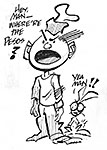
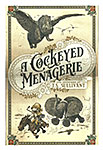
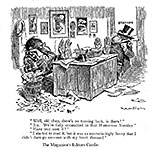
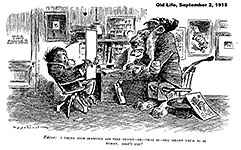
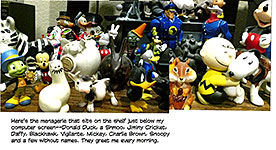
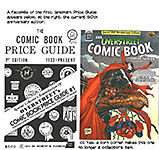
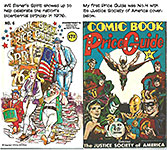
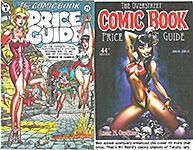
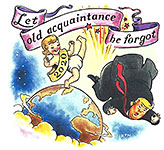
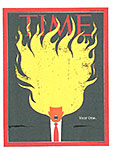
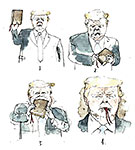
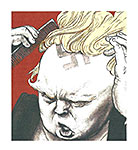

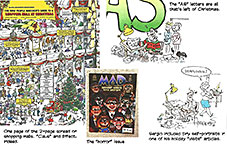
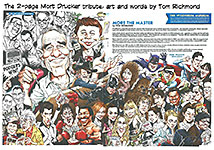
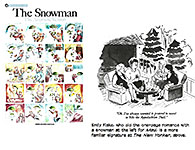
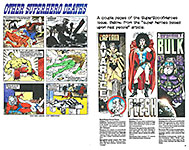
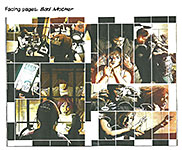
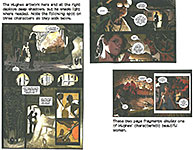
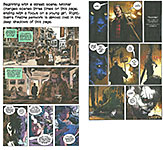
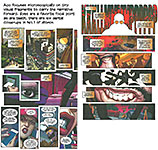
1.jpg)
2.jpg)
1.jpg)
2.jpg)
3.jpg)
4.jpg)
5.jpg)
6.jpg)
7.jpg)
8.jpg)
9.jpg)
10.jpg)
11.jpg)
12.jpg)
13.jpg)
14.jpg)
15.jpg)

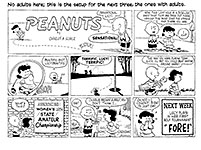
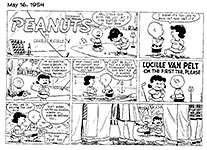
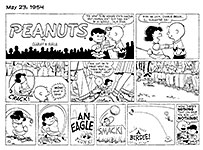
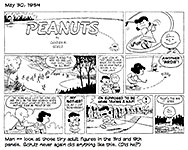
1.jpg)
2.jpg)
3.jpg)
4.jpg)
